RIAA Award Guide: Why Gold and Platinum Awards Are Popular With Collectors
 New to collecting record awards, popularly known as "gold" or "platinum" records? Or have some knowledge and just want to know more about these fascinating pieces of music history? We created this guide to provide information and history on record awards. We hope you find it useful and don't forget to check out our current selection of RIAA Gold and Platinum and other record awards for sale here.
New to collecting record awards, popularly known as "gold" or "platinum" records? Or have some knowledge and just want to know more about these fascinating pieces of music history? We created this guide to provide information and history on record awards. We hope you find it useful and don't forget to check out our current selection of RIAA Gold and Platinum and other record awards for sale here.
Record awards have been part of music history for decades. They have become part of the musical landscape, appearing in photos far and wide and even on fan collector cards. Here are the Beatles in the mid-sixties with some of their newly-presented RIAA Gold Awards on one of those collector cards:
And below is Elvis Presley pictured around 1972 with one of his record-setting total of 101 RIAA awards. With 146.5 million in U.S. sales alone (and still climbing) Elvis has earned the most Gold Album Awards of any artist in RIAA history.
To start off this guide, take note that there are various types of record awards out there in the marketplace:
RIAA (Recording Industry Association of America) awards: The RIAA started its Gold® and Platinum® Sales Award Program to recognize and measure the sales achieved by recorded music releases. These are the only official, third-party-audited and limited production record sales awards out there. The RIAA has actually registered the terms Gold, Platinum, and Multi-Platinum™ as service marks. RIAA awards are the most valuable to collectors and are the focus of this article.
Record label awards (known as "in-house" awards) and other industry awards: These awards are made for record labels or artist management at their direction only (not involving the RIAA) and can be identified by the record company name on the plaque instead of the RIAA logo. They are used to recognize label staff, artists and their managers and teams, and a myriad of other people involved in the production, marketing, promotion and distribution of their recordings, or essentially whoever the label wants to give them to. Most are nicely produced, often by the same manufacturers as RIAA awards, although they are typically manufactured in higher numbers than RIAA awards making them less rare. They are considered the second most valuable by collectors, with the older awards in particular being the most desirable.
Here are a few examples from different eras. From top to bottom: A 1965 "Disc Award Ltd." plaque for The McCoys "Hang On Sloopy", a 1972 Disc Award Ltd. plaque for Elton John's Honky Chateau album, a 1978 Casablanca label award for The Village People's "Y.M.C.A.", an early 80s Fantasy Records award for a cache of CCR's albums, an early 80s A&M Records award for Styx album The Grand Illusion, a 1980s Epic Records award for Cheap Trick's "I Want You To Want Me", a 1990s award for George Strait, created by artist management or his label, and an early 2000's MCA award for Mary J. Blige album No More Drama.








Roughly alongside record label or artist management awards in terms of value, and at times worth more, are Ampex Golden Reel Awards. These were created by Ampex, the magnetic recording tape manufacturer. They were international awards for studio albums and singles that were recorded and mixed entirely on Ampex brand audio tape, and which also sold enough units to achieve "gold" record status in their country of origin, which varied by territory.
They feature prominently a gold-toned Ampex take-up reel. One was typically presented to each of the artist and the studio where the project was recorded. The first award was presented in 1977, and the 500th in 1986, with the awards being made until the early 1990s. Since the program is now defunct and there are relatively few in circulation, the awards have gained in value. They are also quite attractive, with the gold-toned reel and presentation plate affixed to a black plexiglass base.
Earlier designs had a curled piece of plexiglass coming down from the reel designed to replicate a piece of tape drifting down. Here's an example of the early style award, this one for Ted Nugent's 1980 album Scream Dream:

Here's an example of a later Ampex award, this one presented to Bill Wyman of the Rolling Stones for their 1986 Dirty Work album:

Other World Music Market Awards: Other countries have organizations similar to the RIAA who have also created sales based awards. Examples include BPI awards (U.K.), CRIA awards (Canada) and BVMI awards (Germany), ARIA (Australian Recording Industry Association), IRMA (Irish Recorded Music Association), and RIAJ (Recording Industry Association of Japan). These awards are also strictly controlled by their respective organizations. To identify them it's best to get to know the official logos for the various country versions, which must appear on the awards for them to be genuine. Some countries, such as Australia, started official awards programs only quite recently. Prior to their record industry trade organization awards, label-issued awards served the purpose, such as the Australian example shown below. Each of these awards have their own specific designs by era just as RIAA awards do.




CRIA (Canadian), BPI (British), Australian, BVMI (German), RIAJ (Japanese) record awards (top to bottom)
Replica record awards: These are designed to look somewhat like actual RIAA, record label awards, or other territory awards, but on closer inspection do not contain the proper elements, labels, logos and so forth since they do not own those brands or "marks." These are desirable wall decorations to some, but have essentially no value to collectors since they are mass produced for consumer sale. They also are not typically produced at the time that the recording it features actually attained its recognized sales level.
Counterfeit RIAA awards: There are some counterfeit RIAA awards in the marketplace. These are awards that are designed to look like actual RIAA awards. They were made by manufacturers not authorized by the RIAA to make awards. Some are quite good copies, others not so much. Ultimately, the makers of these awards utilized the trademarks of the RIAA when not authorized to do so.
History of RIAA Awards
RIAA awards are created exclusively through the RIAA, a trade organization founded in 1952 that represents the interests of major recorded music sellers, i.e. record labels large and small. The organization lobbies for laws favorable to the industry, works to stop piracy (unauthorized copying of recorded works), and works generally to help the music industry.
They started their Gold® and Platinum® Sales Award Program to recognize and measure the sales achieved by recorded music releases.
 Several eras of RIAA awards on display at an auction house
Several eras of RIAA awards on display at an auction house
In the earliest days, many less of these awards were created, making the earlier awards a rarer commodity and thus more valuable to collectors.
The first RIAA Gold award was issued on March 14, 1958 for the 45 rpm single “Catch A Falling Star” by Perry Como. On July 8, 1958, the first Gold LP was awarded for the cast soundtrack of Oklahoma! sung by Gordon MacRae.
The Platinum single award was first introduced in 1976 with the first award being earned by Johnnie Taylor for his 45 single “Disco Lady.”
The first Platinum LP award went to the Eagles on February 24, 1976 for Their Greatest Hits 1971-75. As of the writing of this article in early 2019, this album also now holds the distinction of being the biggest selling album of all time in the U.S. at 38 million units sold.
In terms of sheer number of RIAA awards, Elvis Presley holds the title for solo artists, while the Beatles hold the group record. They both stand a chance of retaining their top spots since in both cases their music is still selling.
Gold and Platinum Mean How Many Sales?
The number of records that needed to be sold or value of sales required for the various levels of certification has changed over time. Here's a simplified guide:
1958-1974
Gold for 45s/singles: 1 million copies sold
Gold for LPs/albums: $1 million dollars worth of sales. This actually can be a useful piece of information to determine authenticity of an award. i.e. If the presentation plate for a LP/album award issued from 1958-1974 does not read this way you know it can't be a genuine award.
Similarly, Platinum awards did not exist until 1976. So if you see for a 45/single or LP/album RIAA platinum award issued from 1958-1975, you know it can't be genuine.
1975-1988
Gold for 45s/singles: 1 million copies sold
Gold for LPs/albums: 500,000 copies sold
Platinum awards 1976-1981 (introduced in 1976):
Platinum for 45s/singles: 2 million copies sold
Platinum for LPs/albums: 1 million copies sold
In 1984 the Multi-Platinum™ award was introduced (2x, 3x multi-Platinum, etc.) The song "We Are The World" by USA For Africa became the very first multi-Platinum song at 4X multi-Platinum in 1985.
When cassettes came into mainstream popularity in the mid-1980s the language on the awards was changed to X number of "albums and cassettes" sold.
1989-present
Sales requirements for single awards were reduced due to declining singles sales (at that time more consumers were buying albums). Also note that some of these standards, such as the maxi-single certification level, were used only sporadically since 1989:
Gold for maxi-singles: 250,000 copies sold
Gold for singles: 500,000 copies sold
Gold for albums: 500,000 copies sold
Platinum for singles: 1 million copies sold
Platinum for albums: 1 million copies sold
Multi-Platinum single or album: 2 million or more copies sold
Additional notes:
Upon the introduction of the CD in 1992 the language on the awards was changed to X number of "albums, cassettes and CDs" sold.
In 1999 the Diamond award was introduced, signifying 10 million in sales. This is not a framed award but rather a tall crystal statuette.
Digital sales, downloads, ringtone sales, and streams were added as unit sales to be counted in totals for award sales numbers at various times through the 2000's to reflect the addition of these music sales formats.
RIAA Video Awards: Added around 1980, these awards were created to recognize sales of both VHS and DVD Music Video Single releases (one or two music videos or tracks), Longform Music Video releases (concerts, music video compilations not previously theatrically released), and video box sets.
Sales requirements for video awards haven't varied much through the years and are as follows:
Gold for Music Video Single: 25,000 copies sold
Platinum for Music Video Single: 50,000 copies sold
Multi-Platinum for Music Video Single: 100,000 copies sold
Gold for Music Video Longform: 50,000 copies sold
Platinum for Music Video Longform: 100,000 copies sold
Multi-Platinum for Music Video Longform: 200,000 copies sold
One final video category for which awards were issued is Music Video Box Set. This is a classification for video compilations with three or more videos that are marketed together as a set. The certification levels are the same as for Music Video Longform.
The current best-selling music video box set certified by the RIAA as of this writing is the Rolling Stones' Four Flicks DVD compilation from their Licks World Tour, at 19X Multi-Platinum designation.
Replica Record Awards and Why Collectors Avoid Them
If you're a music fan or collector, you've no doubt seen the many gold and platinum awards being sold all over the Internet and in stores. Here's one slightly worn example featuring Electric Light Orchestra:

Some of them are fine looking pieces of artwork for fans of the artist featured, others not so much, but do they have any value for collectors?
The short answer is: Not likely.
The longer answer is that they are worth whatever someone wants to pay for them. This is not to criticize those who buy them to enjoy or those who make them. However, it is unlikely that buyers of these replica awards will be able to sell them down the road for any amount more than they bought them for.
Why?
Because they are mass produced and can be manufactured by anyone.
That is where RIAA awards differ. RIAA awards are manufactured under tight controls. In fact, only a record label that owns the rights to a recording can order a RIAA award for that recording. Further, they can only order them when they:
1) Prove with accounting data that a release has sold the required number of copies for the specific level of certification. This is often done using artist royalty statements. The required measure for this has changed over the years and ranged from a certain minimum dollar value of sales to physical copies sold to digital copies plus physical copies sold,
and
2) Authorize an award to be created for an individual or company that the label wants to receive one of these awards.
Only RIAA-authorized vendors are permitted to manufacture these awards and the RIAA endeavors to stop anyone making counterfeit awards. In the words of the RIAA:
"We regularly work with our member companies and outside agencies to ensure that counterfeits are not readily available on the market. Working together with Sotheby’s and other auction houses and in coordination with its anti-piracy division, RIAA has been able to identify and remove unauthorized awards from auction..."
Official Manufacturers Of RIAA Awards
The current makers of the awards are: Dejay Gold/Products, Gold Rush Vinyl, Jewel Box Platinum, Metro Pro LLC, and The Award Group.
Past authorized RIAA award makers have included New York Frame & Picture Co., California Gold Record Co., Creative Glassics (not a typo, that's Glassics with a "G"), Fitzgerald-Hartley Marketing, Ill-Eagle Enterprises, J.F. Duke Marketing, Milestone Awards, and Off The Wall Limited Inc. Nashville-based framers The Rite Angle and Al's Custom Frames & Gallery, Ltd. also made some official RIAA awards in the past, mostly (but not always) in the country genre. For visual identification, below are photos of labels from most of these companies, although note that many of the labels from these companies changed over time as detailed further on in the guide.















Who Can Get RIAA Awards?
Now we are getting to the reason why these awards are rarer than an off-the-shelf plaque made by anyone. This is because the only people that receive these awards are those authorized by the RIAA and the record label of the particular recording.
Per the RIAA:
Essentially, no one outside of the artist or their creative, executive or marketing teams (which in more recent years has expanded to include radio station personnel, certain music retailers and distributors) can have RIAA awards made for them.
This is what makes RIAA awards so collectible. Not only are they beautiful, shiny pieces of art that pay tribute to our favorite artists' achievements, they also stand a chance, at least, of appreciating in value.
Here's where we have to add a disclaimer, of course, since no one can guarantee any return on an investment collectible. That said, returns cannot be guaranteed on a purchase of stock either, so collectibles can make excellent alternative investments that help to diversify a portfolio.
What Do Real RIAA Awards Look Like?
As for how the awards look through the years, note that just as the list of potential recipients has changed over time, so has the appearance of the awards. We'll delve into all the details on their distinctive features, history and construction further below but first here's a quick list of the different styles produced over the years, with the monikers that collectors have assigned to awards from the different time periods:
1958-63 "Walnut Plaque"
1964-early 75 "White Matte"
1975-81 "Floater"
1981-85 "Floater" (Fitzgerald-Hartley)
1982-85 "Strip Plate"
1986-89 "Flower Hologram"
1990-97 "R Hologram"
1998-present "Bar Hologram"
1999-present Diamond award (10 million units sold)
In this section we'll provide details on how the awards from the various eras look, who award recipients were, and other information. Note that we'll give the most detail on the oldest era awards (1985 and earlier) since they are the most valuable to collectors.
While doing research for this guide we spoke with some of the craftsmen who actually created RIAA awards from 1964 through 1985. That included members of the family that ran the New York Frame & Picture Co., who were the only makers of RIAA awards from 1964 to around 1987, and a former employee of Creative Glassics. The latter was the second company to make RIAA awards that started manufacturing awards (in addition to NYF&P Co.) around 1975.
Every official RIAA award created from 1964 until around 1985 was made by one of these two authorized companies. Much of the information you see here was provided by them.
It's worth noting that one thing that both of them said is that at times there were sometimes subtle variations in certain components of RIAA awards that were made in the 60's through early 80's.
These included variations in:
- The fonts and the method the information was put on to the presentation plates (silk screened, acid-etched or engraved) since a variety of trophy shops were used to make the plates, or sometimes simply due to the same shop changing methods or fonts at their own whim.
- Frame materials and even colors due to custom orders that occurred or because of difficulties in finding supplies of previously used materials. The vast majority of frames are either naturally stained wood, or wood frames painted gold or painted silver, depending on the year the award was produced (see below). However, very rarely there are also white frames and even green frames out there due to special requests. Some of these awards are originals that were painted afterwards (for example to match the decor of the office/location of the person displaying it), but some were actually ordered with different finishes. There were also variations in other aspects of the frames due to simple supply issues experienced by the award makers.
- Mattes used, although there is fairly clear distinction that can be pegged to different time periods (see below).
The point is that it can be very difficult to determine the authenticity of an award based on just one of these elements, since an award could have been custom ordered or been made with alternate materials to that of those previously manufactured. For this reason, when attempting to ascertain authenticity, it's best to consider all the various attributes of a RIAA award to make a determination.
Were The Discs Actually The Artist's Record And How Were They Made?
The short answer is most of the time, no.
As to how they were made, until around 1985 nickel "stamper" or "mother" discs were used. The nickel stamper disc was thinly plated in real gold for Gold awards and left bare for Platinum awards due to their natural silver or "platinum" color.
The stampers were almost never, although occasionally, a disc of the actual record being recognized in the award. This is why you will often see that the number of tracks on the records ("bands") sometimes does not match the number of tracks on the label for the record being recognized. The former Creative Glassics staffer said that many of the records used on awards he made in the early 80's were actually salsa records.
He also relayed that when Bruce Springsteen learned that his records were not being used, "The Boss" insisted that all his awards that were to go to his closest friends and business team would, in fact, be made from his own records.
Post-1985 vinyl records instead of the metal mother discs were used for the awards, and they were gold and silver plated with a newer process.
Details By Awards Era
Here are other details of RIAA awards by era:
1958-63 "Walnut Plaque" period: In the earliest days, they were only made for a very small number of people, the artist and perhaps only 1-2 others. No one really knows the numbers created for each project in the earliest days.
The awards, as the nickname implies, were essentially a walnut plaque with a gold plated metal mother disc and an RIAA logo medallion affixed, along with a presentation plate.
1964-early 75 "White Matte" period: So named due to their distinctive white-colored matte materials, white matte awards were designed with a gold plated record from a metal mother disc that was cut into the matte, a matted-in album "miniature" that was a printed replica of the album cover, and a gold toned presentation plate with the RIAA logo. Here is Aretha Franklin and her husband/manager Ted White (R) along with her producer Jerry Wexler with some of her white mattes awarded in 1967:

Note that only Gold awards were produced. There were no Platinum awards in the white matte period since that program was not launched until 1976, after white matte award were no longer made. If you see a "Platinum" white matte, it is not a genuine RIAA award.
The presentation plates on the awards were acid-etched on white matte awards vs. the silk screened versions used on floater-era awards. One can see the difference in an acid-etched plate versus the silk screened most easily by placing a gold floater award next to the white matte award you are assessing. The black portions on the presentation plate on the white matte should have a slight bit of relief, i.e. an ever-so-slightly raised surface that is usually most apparent when looking at the RIAA logo.
The fonts used on the plates varied over the years. According to a former family employee of New York Frame & Picture Co., the exclusive maker of the awards from 1964-early 75, local trophy shops were used to create these plates and this is why over time the fonts varied somewhat. At some point in the 70's, the plates were pre-printed with the standard language below, and the album title, recipient and label information was then typically engraved onto the pre-printed plates, with other plate print processes used in later years (post-1981):
For Gold LPs/albums 1964-early 1975
PRESENTED TO
[award recipient]
TO COMMEMORATE THE SALE OF MORE THAN ONE MILLION DOLLARS WORTH OF THE
[XXX record label]
LONG-PLAYING RECORD ALBUM
[album title]
(Note that the LP language would change on post-1975 awards).
For Gold 45s/Singles 1964-early 1975
PRESENTED TO
[award recipient]
TO COMMEMORATE THE SALE OF MORE THAN ONE MILLION COPIES OF THE
[XXX record label]
SINGLE RECORD (sometimes POP SINGLE RECORD)
["song title"]
Construction Of White Matte Awards
As for construction, before 1967 these awards used off-white Bainbridge #14 matte board, with its distinctive color and crisscross, burlap-like texture. The mattes were hand cut.
From 1967-early 1975 white Miller board was used. This material also has a texture, but it is smoother and has a whiter appearance. Also, these mattes were die cut.
In both early and later white mattes, the disc and other elements were "matted in" as opposed to 1975-81 "floater" awards, in which the elements are mounted on top of the matte.
Here is detail of the "matted in" plate and record on an early hand-cut, Bainbridge board Gold single award for the Beatles "A Hard Day's Night," which was certified Gold on August 25, 1964:
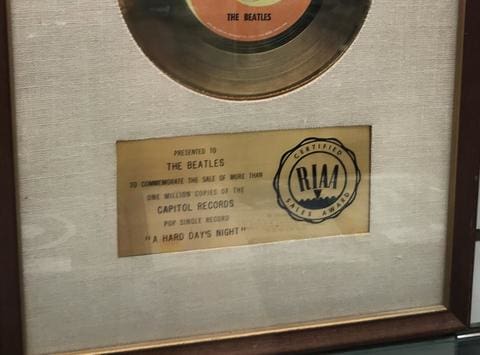
Compare this to the smoother, whiter, die-cut Miller board seen here on this award for The Doors track "Hello, I Love You" which was certified Gold on Aug. 28, 1968:

These awards also featured walnut frames with gold trim on the inner part of the frame. They had heavy brown craft paper backing (which often gets brittle with age and tears easily), and wire hangers (sometimes you will see these replaced with saw tooth or "wall security" hangers but they were only originally made with a wire hanger into screw eyes).
Here are a couple more examples of white matte awards. First, here is a white matte single award for The Rascals "Beautiful Morning" presented to guitarist/founding member Gene Cornish. White matte awards for singles/45s measure 13-1/2" x 17" (34.29 x 43.18 cm). Since this is an award from early 1968, note the earlier coarse-textured Bainbridge matte:

Here is a white matte award for a later single, the Rolling Stones "Angie" presented to 1969-74 Stones guitarist Mick Taylor. Since this is an award from 1973, note the later era smooth-textured Miller board matte:

Here is an album award for The Doors 1970 album 13 presented to Jim Morrison. It was certified Gold in 1972. White matte awards for albums/LPs measure 17" x 21" (43.18 x 53.34 cm). Note the smoother Miller board used post-1968 and inclusion of album cover miniature:

Manufacturer Stickers And What They Can Tell Us
Best for collectors is when a New York Frame & Picture Co. sticker is still affixed like the examples shown below. Also, let's pause on our description of white matte awards for a moment and talk about manufacturer stickers and how they can help collectors determine the age and authenticity of an award.
The address on the NYF&P Co. sticker is useful in determining when an award was made since the company moved locations at least once during the time they made white matte awards. Also, the sizes of the stickers used on 45 and LP awards were different.
Sometime in 1969 the New York Frame & Picture Co. (NYF&P) moved from 141 Fulton St. to 29 John St. in New York City. Knowing this helps to peg manufacture dates of awards that still have an original sticker affixed with these addresses. i.e. It can indicate that an award was made, or at least that its backing paper was installed, either pre-1969 or post-1969.
It's important to note, however, that the existence of a post-1969 NYF&P label on a pre-1969 award does not necessarily indicate that the award is inauthentic. In fact, a decent number of the pre-1969 "early" white matte awards sold by major auction houses today have 29 John St. stickers on them. Why is this? It's only speculation but it could be that early backing papers quickly disintegrated and had to be replaced by NYF&P. In some cases these white matte awards could have been restored by NYF&P post 1969 after being damaged or getting dirty.
Ultimately, the only thing the existence of a 29 John Street sticker on a white matte award proves is either that it was first manufactured from 1969 to early 1975 or that it was rebacked during that time period. Since the same 29 John St. stickers were used on 1975-84 floater awards, the rebacking of a white matte could also have been done during that period. After 1985, the company changed the style of its stickers (see that new style below under the "flower hologram" award description).
The first image here shows the sticker on an LP award for War Live album from 1973, on which slightly larger labels were used. The 29 John St. address also dates it to post-1969 since the company was at other locations prior to 1969:

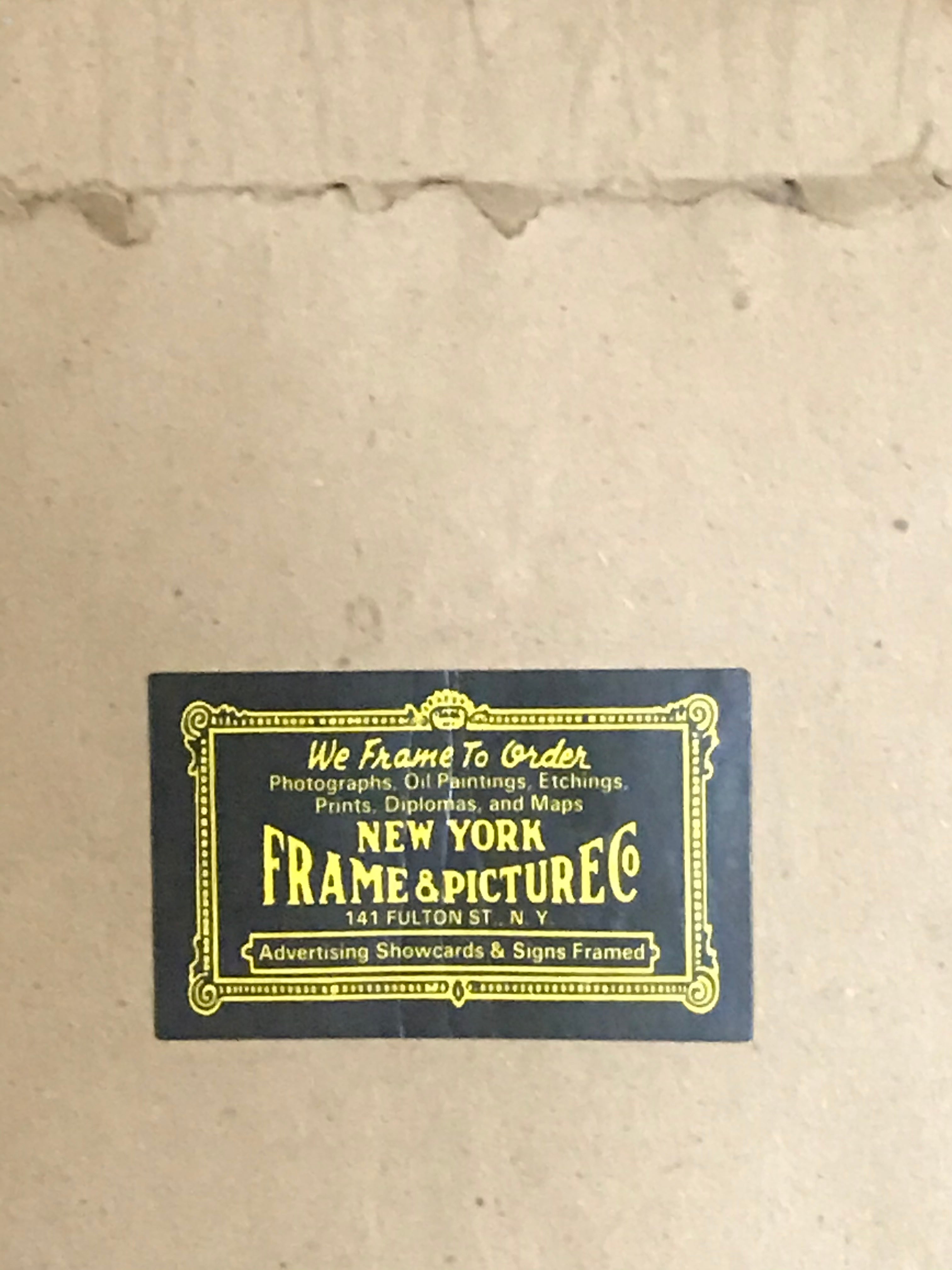
This third image shows the smaller sticker sometimes seen on 45 awards. Even though the sticker in this example is partially damaged, it's existence helps to indicate award authenticity. Note that this is a pre-move NYF&P Co. 141 Fulton St. address on this early white matte award. This is also an example of the simpler label design sometimes seen (this is from a 1968 Rascals award for "People Got To Be Free"):

Label-wise, second best is when an original backing paper has survived with the sticker having fallen off, as long as there is a sticker residue spot of the correct size and shape where it was once located. This was normally in the upper middle of the back.
For example, despite the tears, the condition of the award back below is more desirable to many collectors than a changed backing paper because you can see the proper location and size sticker residue near the top middle. The idea is that this unopened condition pretty much guarantees unaltered interior components:
That said, some prefer to simply replace a torn backing paper. If this is done, it is recommended to: a) Take good photos of the original backing, and b) Leave the original backing paper on and simply re-back over the original.
If repairs need to be done to the internals of an award (for example, re-attaching a presentation plate that has fallen off due to its glue drying out) and at least one side of the backing paper at the frame is intact, try and leave the intact side uncut. By doing this you can retain the original award backing paper. If it is still present, it's also best to try and retain the manufacturer sticker in its original location.
To close up the award, seal the three cut sides with brown paper tape or clear cellophane tape. Performing a repair in this way can help preserve the award's value to serious collectors. Here's an example of a 1971 white matte RIAA award post-repair. Note that the backing paper has not been cut on the top side:

It Was The Summer of '69: Flipped Presentation Plates
One interesting anomaly in white matte awards occurred over a six month period from, roughly, Spring to Fall in 1969 when the position of the presentation plate and album miniature were flip flopped, with the plate located on the left of the award instead of the right. Here's an example of one of these unusual mid-1969 white mattes on the top for The Doors The Soft Parade, certified RIAA Gold on August 5, 1969 compared to a white matte made in 1970 on the bottom for The Doors Absolutely Live:


In talking to the former NYF&P Co. family employee, he indicated that perhaps a batch of the mattes were die cut upside down and rather than discard them, they were used up until they ran out during this time period. However, this is only a theory and even though we spoke with those in the family business that made them, they were not sure. Not many of us who worked 50 years ago in a busy New York City frame shop would remember such a mundane detail either.
Here's another example for an Engelbert Humperdinck award for his A Man Without Love album, which was certified Gold on February 27, 1969:

Other White Matte Details
Finally, the presentation plates in white mattes are acid-etched vs. the silk screened plates used in 1975-81 floater awards. There are however, at least a small handful of different fonts that were used on the awards from this time period.
As to award recipients, artists, studio musicians, label executives and producers typically received awards during this period, and only between 5-25 total per release were produced.
Here are The Cowsills getting a white matte single award for their song "The Rain, the Park and Other Things" in 1967 which was certified Gold on Dec. 19, 1967. Who knew that these same folks would score another Gold award for the single "Hair" a year and half later?

Want even more details on RIAA white matte awards, including a peak inside them? Check out our in-depth article here.
1975-81 "Floater" and 1981-85 "grey area floater" period: It is notable that a second and third maker of RIAA awards joined New York Frame & Picture Co. around 1975. New Jersey-based Creative Glassics was also named as an officially authorized manufacturer along with Nashville-based Al's Custom Frames & Gallery Ltd., the latter of which mostly (but not always) made Country genre awards.
Both the companies began to make a new style of awards, nicknamed "floaters" by collectors. These awards are so named because the disc, presentation plate and album miniature (on album versions) were mounted on paper-based blocks such that they appear to "float' on top of the matte. This type of award was produced from 1975-81 (technically through Jan. 1982).
A second type for singles/45s and occasionally albums can be found in awards made from 1981-85. They are sometimes referred to as "floater type 2" awards and featured all the same construction and materials but the record and presentation plates were mounted closer to the matte, with only a fraction of an inch clearance. While this is only conjecture, it could be that the makers were having problems with the 45 records coming dislodged at times since there is less adhesion area available under the smaller size of a 45 versus an album. In one conversation with New York Frame & Picture Co's founder, he mentioned that they did indeed have problems with this at times until they eventually landed on the use of an adhesive he called "black miracle cement."
Continuing on a description of floater awards, they feature charcoal-colored, slightly textured mattes. The presentation plates were silk screened, giving them a very slightly different appearance than the acid-etched ones on white matte period awards.
The frames were still made of wood but instead of having a natural dark stained wood appearance they were painted in a solid gold color for Gold awards, and silver color for the Platinum awards launched in 1976. Some people believe that the presence of black specks or striations in the frame paint on floater awards is an indicator of authenticity. Our observation has been that NYF&P Co. floater era awards have no such specks or striations while most awards manufactured by Creative Glassics do, and the presence of this or lack thereof is not a reliable indicator of authenticity.
It is very common for awards of this period to have scratches and nicks in the paint on the frame. In some cases a red primer coating was used under the paint and you can see it exposed on the wear spots. However, due to different frame materials being used at times, it seems that red primer is not always present. The two companies did not actually make the painted frame material themselves, rather they ordered it in bulk lengths and cut it for their needs. It is reported that Creative Glassics floater awards made in the first year from 1975-76 featured a high-gloss painted frame, thereafter switching to frames with a more flat-appearing paint finish.
While NYF&P Co. stickers remained as found on post 1969 white mattes, newcomer Creative Glassics' sticker was very different and also located in a different spot on the award backs. Here is a that company's sticker and note that their stickers were normally located on the bottom right corner, while occasionally they can also be found on the bottom left corner:

Floater Award Mattes
Back to floater era awards and their construction... Mattes used in "floater era" awards were made of black-colored, pebble texture matte material. A common trait of these mattes is fading but as long as it is not too severe, it doesn't typically affect the award's collector value. It does make many of them look different from one another, however, since rarely does one award fade at the same rate as another.
Floater Award Recipients
Recipients of the awards added to artists and others involved in the creative process and label execs were radio stations, artist management, agents, and distribution and promotion figures. Between 25-50 awards total were produced per release.
As for the presentation plates, to reflect changing consumer record buying habits the RIAA changed the language on the floater awards to the following:
For Gold LPs/albums 1975-81
PRESENTED TO
[award recipient]
TO COMMEMORATE THE SALE OF MORE THAN 500,000 COPIES OF THE
[XXX record label]
LONG-PLAYING RECORD ALBUM
[album title]
(Note that the LP language would change on post-1975 awards).
For Gold 45s/Singles 1975-81
PRESENTED TO
[award recipient]
TO COMMEMORATE THE SALE OF MORE THAN ONE MILLION COPIES OF THE
[XXX record label]
SINGLE RECORD
["song title"]
For Platinum LPs/albums 1976-81 (the Platinum program started in 1976)
PRESENTED TO
[award recipient]
TO COMMEMORATE THE SALE OF MORE THAN 1,000,000 COPIES OF THE
[XXX record label]
LONG-PLAYING RECORD ALBUM
[album title]
(Note that the LP language would change on post-1975 awards).
For Platinum 45s/Singles 1976-81
PRESENTED TO
[award recipient]
TO COMMEMORATE THE SALE OF MORE THAN TWO MILLION COPIES OF THE
[XXX record label]
SINGLE RECORD
["song title"]
Here's a "floater" album example celebrating Bad Company's Straight Shooter going Gold on May 6, 1975. Just as with white matte awards, floater awards for albums/LPs measure 17" x 21" (43.18 x 53.34 cm). :

Here is a "floater" Gold 45 single award for Queen hit "Bohemian Rhapsody" which was certified Gold on June 3, 1976. Floater single awards measure 13-1/2" x 17" (34.29 x 43.18 cm) just as white mattes. Note also that, just as with white mattes, the single award still did not contain the album artwork miniature.

Here is a "floater" Gold 45 single award for Blondie's 1979 hit "Heart Of Glass", which is an example of a late period floater award (sometimes referred to as "Floater Type 2") in which the record and plate are mounted closer to the matte than in the earlier period:

On Platinum awards, the frame, presentation plate and of course disc on "floaters" were platinum (silver) like this example of the first ever Platinum single award ever issued was earned by Johnnie Taylor for his track “Disco Lady”, which was certified Platinum on April 22, 1976:

Note that when launched in 1976 a Platinum 45 single certification represented two million singles sold. In later years (around 1989) the Platinum single level was adjusted to one million sold. This was done when singles started to sell less units as the album format gained traction with consumers. The RIAA website today shows all Platinum singles as having sold one million units, without differentiating whether they were certified in the "two million sold" or the "one million sold" era.
Here's an example of a Platinum Album floater award for the Earth, Wind & Fire's I Am album, which was certified Platinum for one million copies sold on June 7, 1979:

One thing you may see on floater awards is that the presentation plate "presented to" and recording information has a different font and/or ages differently from the award level information. This is because the award level info is pre-printed on the plates and the recipient/recording information is added when the award is made. Here's an example on a Journey award for their album Evolution which went Platinum in 1979, here presented to a radio industry promoter:

This is also an example of what was referenced earlier, i.e. that different trophy shops were used to make the plates so some variation can be seen in how the plates look. It is true generally that each of NYF&P Co. and Creative Glassics typically each used one standard font. However, the Journey award example shown above with an atypical font in use for the record label name and album title (on an award made by Creative Glassics) shows an example of this occasional variation.
Want even more details on RIAA floater awards? Check out our in-depth article here.
"Grey area" awards made by manufacturers with no official RIAA license: Let's pause for a moment as we look at 1970s and 80s era awards to explore what we call "grey area" awards. This is an interesting topic and not one without controversy among collectors and the officially RIAA-licensed companies who made awards over time. What is certainly a fact is that neither we, nor anyone else, has come forward publicly with any evidence to definitively prove that any company produced awards without a RIAA license, or that any record label or other music industry entity ordered or purchased them from any manufacturer without that license.
With that disclaimer out of the way, we can discuss what some collectors believe and look at some of the facts surrounding this topic.
While the music business has always been full of characters, both on the creative and business side, the 60s through 80s were really the "wild west" days of the industry. Huge profits were made as record sales soared and many people, individual entrepreneurs often, started successful labels, managed artists, promoted concerts, programmed radio stations and so on. It was not the corporatized global business that the industry is today. For a peek inside what it was like, Fredric Dannen's 1991 book Hit Men is a good read and fascinating inside look at what the industry was like [Editor's note: No, he's not a relative of anyone at MusicGoldmine.com...].
The record award manufacturing business was no different. As the record business thrived, and labels wanted to reward more and more industry people with record awards, new manufacturers jumped in to meet the need.
As mentioned above when chronicling the various award manufacturers over time, by the mid-70s the New York Frame & Picture Co. was no longer the only provider, as Creative Glassics became the second license holder, followed shortly after by Al's Custom Frame Shop.
From there, other companies were waiting in the wings and would eventually acquire RIAA licenses as well, some for longer periods, some for shorter. Some were those who had previously made non-RIAA record industry awards, such as Dejay Products. Others were new players, such as Fitzgerald-Hartley, who were in artist management, and California Gold Record Co., who were said to be key in creating the newer process of applying metalized coatings to plastic records that could be used in awards, making them cheaper and lighter to ship.
What is clear is that these companies were all in competition with one another at that point, fighting for all the record labels' business.
And clearly at some point, some labels—no one knows with any certainty which — acquired awards from some other individuals or companies who made awards — again, no one knows with any certainty which — who had no RIAA license. We'll never know this with any certainty because the RIAA makes no records available about the awards made. The only thing publicly available are certification dates for releases that appear on their website.
One theory goes like this: Fitzgerald-Hartley officially became an official award maker after NYF&P Co. and Creative Glassics did, sometime in the mid-80s. While we have not seen definitive proof of this, word is that a former Fitzgerald-Hartley employee involved in making their awards was the one who started creating floater style awards after leaving the company. They did this without being granted a license by the RIAA.
Whoever it was, while not obtaining a RIAA license they clearly had some record label connections who bought these floater-style awards from them during the time period of 1981-85.
Note that this was after the RIAA specified in 1982 that "strip plate" style awards were to be issued from that point forward, until 1985, after which "flower hologram" style awards were specified by the RIAA as the new design. This is why it is possible to find floater-style awards on releases that were certified to Gold or Platinum after 1981 and until around 1985.
While we have seen and examined awards made in the floater style from this time period, the vast majority do not have any manufacturer sticker on their backing papers. In terms of construction they also had glued frames, not the nailed together frames that Creative Glassics and the New York Frame & Picture Co. used. We have seen very few examples of these awards like the Prince Purple Rain "floater" style award pictured below.
The examples we have seen, and that includes awards that are clearly appropriately aged and presented to verifiable industry figures, have had no sticker on what appear to be original backing papers. While this supports the theory that they may have been made by a company or individual without a license, it is notable that this does not prove who made them, regardless of what popular lore is out there among collectors.
Whatever their origin, these awards are made to almost the exact same standards as floater awards of the era. Notable differences are that vinyl records were used with a "gold" or "platinum" metal coating applied under a process newly developed around that time. This process was used in all later awards as metal master discs ceased being used in awards from around the mid-1980s.
It's notable however that neither NYF&P Co. nor Creative Glassics ever made any floater awards without metal master discs in them.
At times different fonts also appeared on the presentation plates and frame materials varied on these awards. All this notwithstanding, these pieces -- as long as they can be traced to the 80s and are not reproductions made more recently -- still make for great collector's items from the time period.
Here is an example of one of these awards (front and back), this one issued around 1984 for Prince's Purple Rain album going Platinum. This award had impeccable provenance, having been given by Prince's bodyguard at the time Chick "Big Chick" Huntsberry (who also appeared as himself in the Purple Rain film) to his attorney:


As other examples of these “grey area” awards, here are details regarding various Van Halen awards that have no manufacturer labels and, like the Prince example above, the story involves awards issued for records released by Warner Bros. Records.
These awards are definitely originals from the 1980s, backing papers and all. They came from a former executive at Warner Bros. who got them from a colleague who was then the Sr. VP of Publicity at Warner Bros. Typically, no one makes fake awards presented to an unknown executive and, more to the point, we have in our possession a Letter of Provenance from the Warner Bros. executive guaranteeing their authenticity. These are real awards from the 1980s time period. So why no manufacturer label if they were made by a RIAA-licensed maker? We'll never know for sure, but it is most likely that they were made by an unlicensed manufacturer.
Here's the front and back of these example awards related to Van Halen's 1984 album. Note the alternate font on the presentation plate, and also that the RIAA "Strip Plate" design was supposed to be utilized in all RIAA awards produced at that time in 1984 (this award is made in the RIAA "floater" style):


Here's one for Van Halen's 1984 single "Jump" which holds another clue that this was likely made by an un-licensed manufacturer: It is constructed in a different size than the RIAA had mandated for single floater-era awards. It is 10" x 14" instead of the standard 13" x 17". Also, note again the alternate font on and floater design presentation plate at a time when the "Strip Plate" design was mandated by the RIAA:


Another example, also from what was supposed to be the 1982-85 "Strip Plate" period. While Aldo Nova's 1982 self-titled album was certified Gold on May 14, 1982 by the RIAA, and the recipient is a verified record label executive--Ron McCarrell, who was VP of marketing for Epic/Portrait/CBS Associated Labels at the time--the record award was not made by a RIAA-licensed manufacturer. Instead, it was made by Starship Picture Framing Co., a company that was based in Brooklyn Heights, New York.
A close examination shows numerous anomalies versus RIAA-licensed manufacturer awards such as a velvet matte (versus a charcoal-colored pebble texture matte), non-standard printing on the presentation plate, and different spacing of the album miniature and plate.

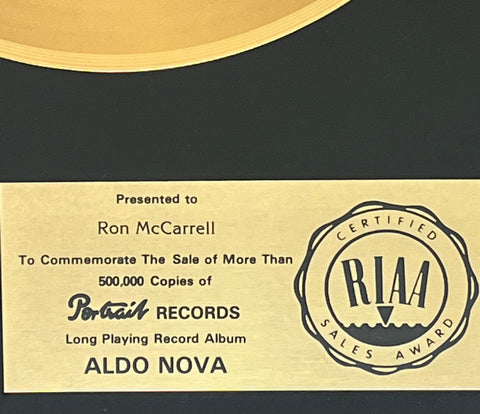

Here's yet another example of an award made in the non-standard way but designed to mostly mirror a "floater" style award, despite being made during the period in which a "strip plate" style should have been made. These awards were, in fact, ordered by artist management and/or record labels at this time in the 80s and given to their desired recipients, making them genuine memorabilia of the era.
This example is for Toto's IV album, which went Gold in 1982. One can see that the font on the plate is not standard (or engraved), the frame is dark brown-stained wood with gold inserts--which is completely different from a standard floater award, and it also has a wood panel backing board with no backing paper:



A final example of an award constructed in a non-standard way, but still an authentic award created at the correct time in the 80s and presented to a verifiable music industry executive--this award is from the 1986-89 “flower hologram” time period. The only two details distinguishing this award from one typically seen as a genuine example are: One, the award’s frame is undersize at 16” x 20” (album awards in this era were all 17” x 21” per specifications of the RIAA), and two, it has no manufacturer sticker. Otherwise, it is made completely to specifications of the time.
It is presented to a verifiable record executive with MCA Records, Janie Hoffman, who was in fact at that time MCA’s National Director of Media & Artist Relations. The award is for Elton John’s 1987 Live In Australia album, which was certified Gold by the RIAA on January 5, 1988:

So, do these examples with construction anomalies and lack of officially-RIAA licensed manufacturer stickers make these awards "fakes?"
No, at least not in the context of "are they genuine music memorabilia?" They are, in fact, genuine artifacts of the era, created and given to verified record executives and others to recognize the achievements of the artists and their records. However, by all examination of the evidence they are also certainly, or in some cases probably, not awards manufactured under license of the RIAA.
Sure, in the eyes of a RIAA-licensed award manufacturer they are no doubt referred to as "fakes." However, in the eyes of a collector they should be viewed as bona fide pieces of music memorabilia. They were owned by people in the industry, they are of the era, and they are typically very similar if not precisely similar to the awards made by the licensed manufacturers. And it’s certainly possible that the theory that they were manufactured by a “soon to be licensed” RIAA award maker is true.
In reality, the only collectors who would object to making these a part of their collection is the one who is such a purist that they want to own only "officially licensed RIAA manufacturer" awards.
So, moving on with our RIAA award eras...
1982-85 "Strip Plate" period: In this era painted wood frames were still used, painted solid gold or silver. The mattes were pretty much the same (charcoal colored). However, the presentation plates combined the "presented to" information with the album miniature on the album/LP awards so that all the components were on one "strip," thus creating their nickname.
Here is a "strip plate" Gold LP award for Elton John's Jump Up! album, presented to Sir Elton's songwriting partner Bernie Taupin, made after it was certified Gold on November 2, 1982:

Here is a "strip plate" Platinum LP award for The Fixx's Reach The Beach album made after it was certified Platinum on Jan. 5, 1984:

Multi-Platinum awards in the strip plate era utilized chrome frames and, for the first time, introduced cassettes and an album miniature for each one million units sold. Here's a 1985 strip plate award example for Tina Turner's 1984 Private Dancer album, which was certified 3x Multi-Platinum on February 5, 1985:

An unusual strip plate style rarely seen but in existence here and there is the "dual Gold/Platinum" presentation, like this large 1984 award for John Cafferty & The Beaver Brown Band's Eddie and the Cruisers soundtrack album:

As for single/45 rpm awards in the strip plate era, there seem to be two types out there:
The first 45 award type of this era adopts the same strip plate style design as the LP award. It has a divider line between the RIAA logo and the presentation info, although it does not include an album miniature.
The second type is with a plate that looks essentially identical to that of a floater era award (with no line) except that instead of the disc and presentation plate being mounted on blocks that raise or "float" them off the surface of the matte, they lay flat on the matte. One collector dubs this second type "45 Strip Plate Type 2" awards.
It's unclear whether this was because there were two manufacturers by now (NYF&P Co. and Creative Glassics) or because there was a change in design mandated by the RIAA, but there are these two types of 45 awards out there from this time period.
Here's an example of a "45 Strip Plate" award for Foreigner's "I Want To Know What Love Is" from early 1985:

One other detail of the "strip plate" period is that the two manufacturers utilized different fonts on the presentation plate album/track information. New York Frame & Picture Co. used a wider font as shown here on this plate from a 1984 Big Country RIAA award plate:

Creative Glassics used a narrower font like the one shown on this 1983 Blue Öyster Cult RIAA award plate:

1986-89 "Flower Hologram" period: In 1985 the RIAA decided to start using hologram RIAA logos for the awards. The first era of these were nicknamed "flower holograms" due to their appearance.
In terms of recipients, added to the previous recipient groups were others including record stores (primarily big chains) and specialty users like Hard Rock Cafe who were seen as helping to promote music. From here on out, the recipients of awards have been relatively stable but include all the industry groups mentioned.
Here's an example of a flower hologram award for The Cars Greatest Hits album, certified Gold on January 16, 1986. Note the addition of a cassette in the award for the first time in this era, reflecting the significant sales of this format:
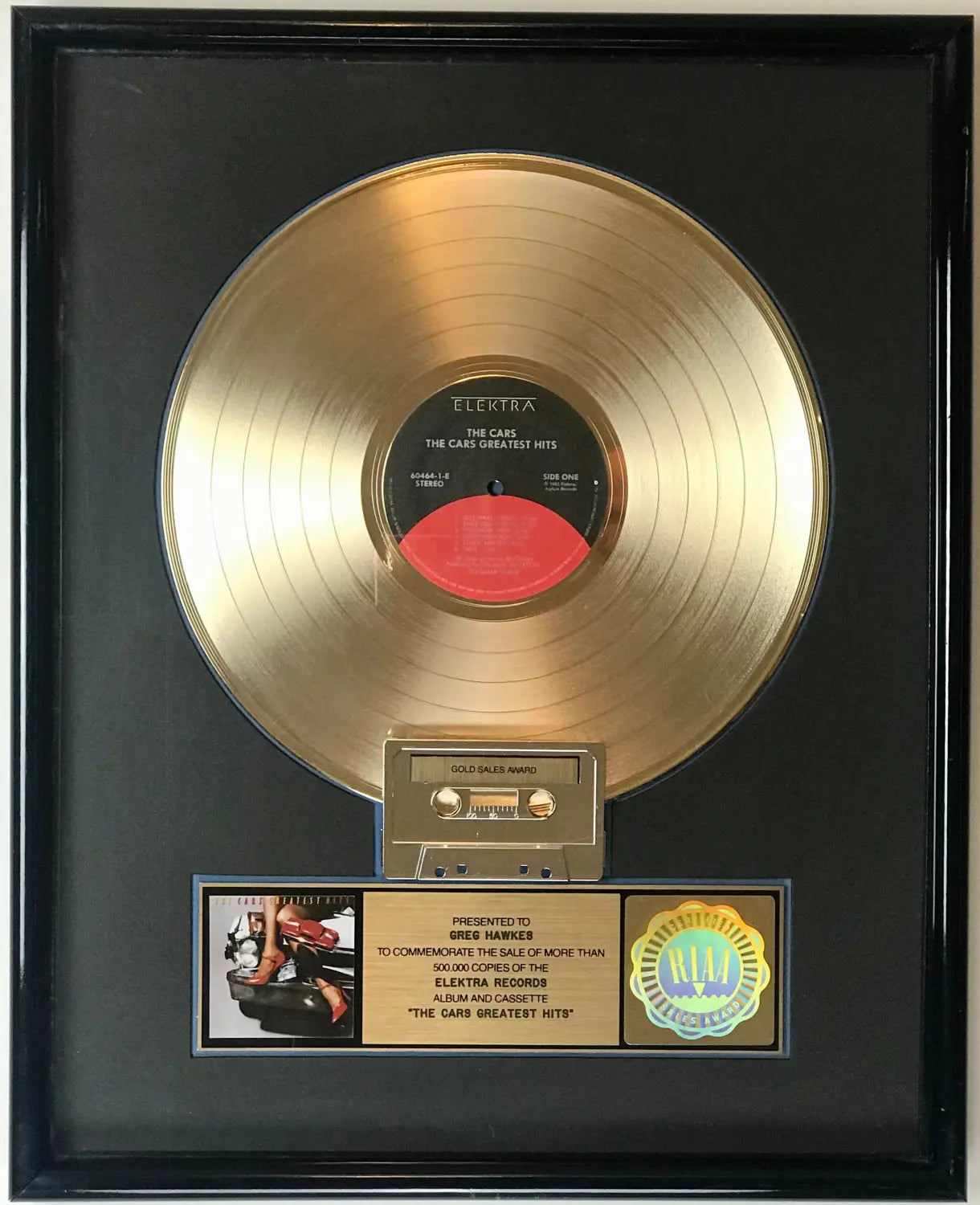
In the flower hologram period, Platinum or higher awards were made in the earlier time period with chrome frames, like this 4x Multi-Platinum example for Boston's Don't Look Back album, which was certified on October 20, 1986:
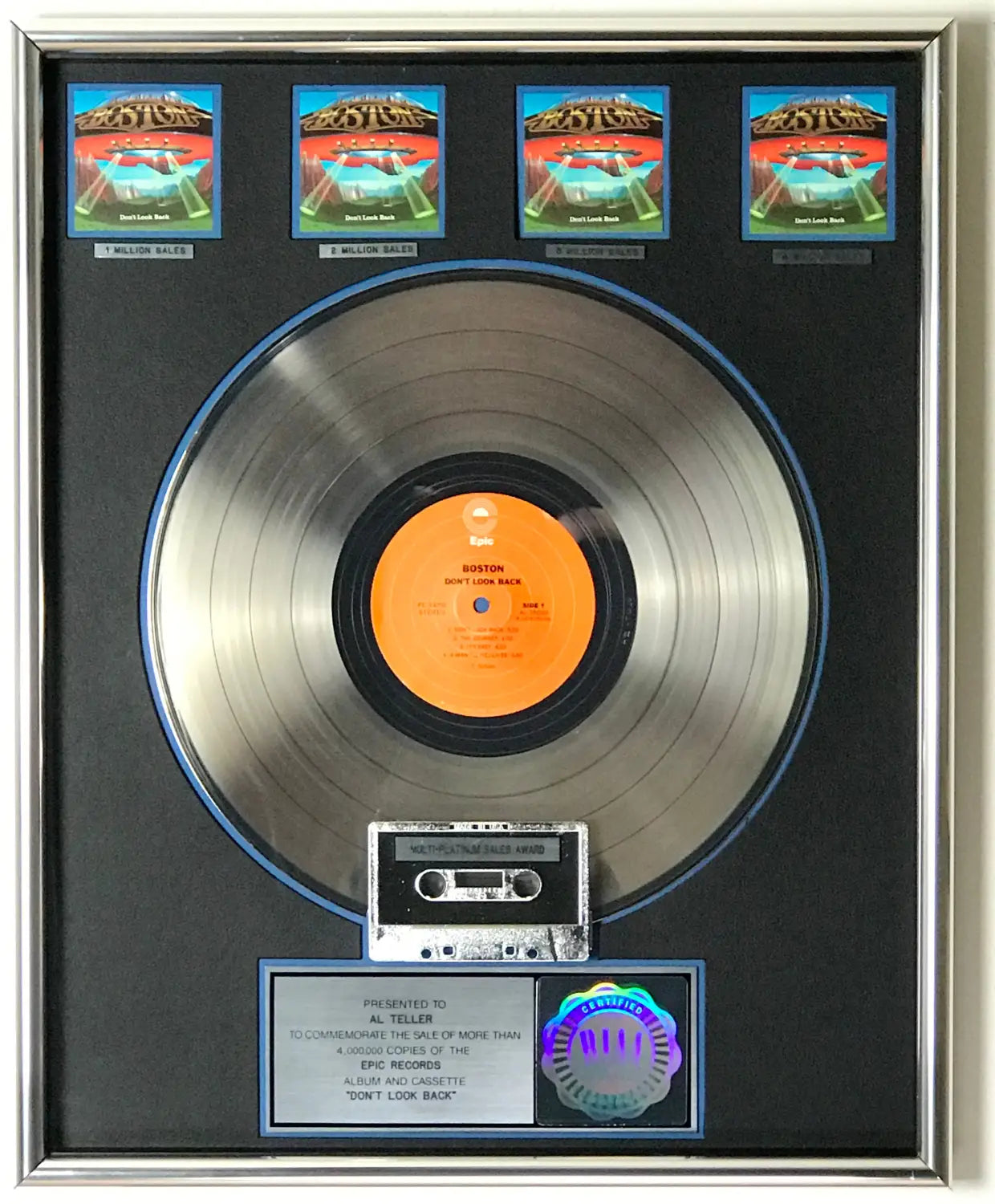
In the later period, the RIAA approved other alternative presentations for Multi-Platinum awards, like this one which also introduced the new CD format. This award celebrates U2 album The Joshua Tree being certified 5x Multi-Platinum on October 6, 1988:
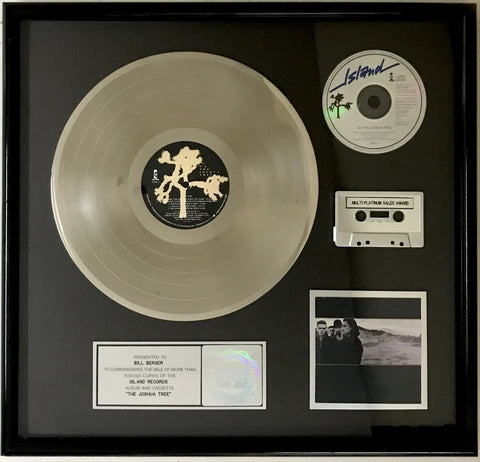
Another feature that appeared occasionally starting in the flower hologram award era was a metal plate with a Billboard chart position for a track, like this example for The Beach Boys "Kokomo" from 1989:
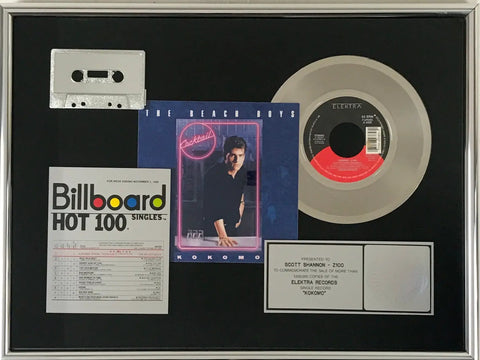
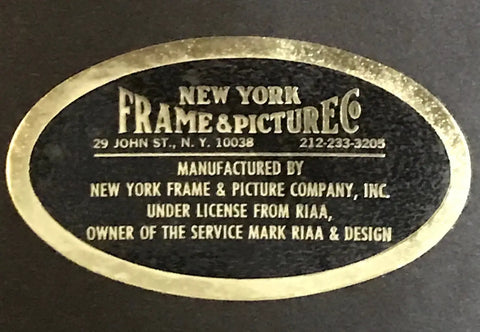
Here’s an example of a later Creative Glassics sticker, also with additional language regarding their status as an official RIAA award maker:
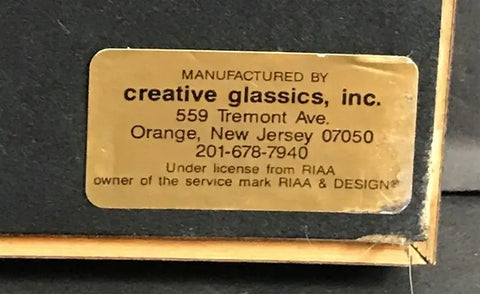
One notable detail about awards made during the flower hologram period is that plastic discs were used almost exclusively. The exception was NYF&P Co., because that company never made any awards without metal master discs, including flower hologram style awards, which was the last style that company made before going out of business in the late 80s.
The owner of the company stated this in an interview that we conducted with them. If you find a flower hologram award made by them, you will find that it is noticeably heavier than those made by other companies due to the weight the metal disc adds to the award. Here's an example, also showing that company's final era manufacturer sticker before they went out of business in the mid-80s:
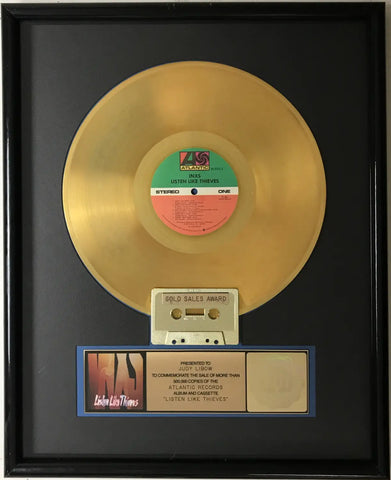
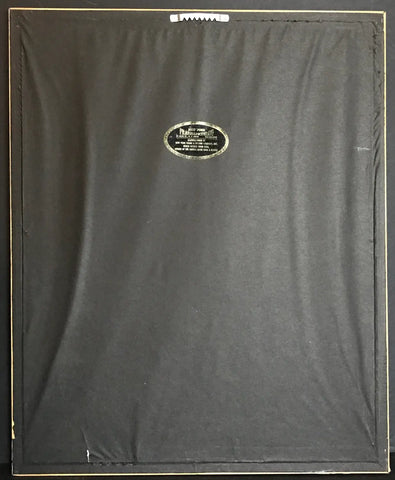
1990-97 "R Hologram" period: During this time period, new companies began to manufacture the awards. While Creative Glassics still made some awards until ceasing in 1995, NYF&P Co. had stopped making them in 1987. New manufacturers included Fitzgerald-Hartley and Ill-Eagle Enterprises. The "R Hologram" awards are so named due to the large "R" shape of the new RIAA hologram design. Note also the addition of a CD to the record and cassette in these awards. This time period also marked a period of more freedom for award designers. Here's a more classic design on this "R hologram" award for Roxette album Look Sharp! which was certified platinum on Jan. 18, 1990:

Labels ordering awards in this period could also choose from more designs, from more traditional designs featuring records, to awards with a combination of records, CDs and cassettes or other versions. Here's a Fitzgerald-Hartley single award issued in 1990 for Great White's "Twice Shy". Notice the newly added feature of a plate stuck right onto the record reading "Gold Sales Award", which is seen at times on both 45 and album awards in this time period:
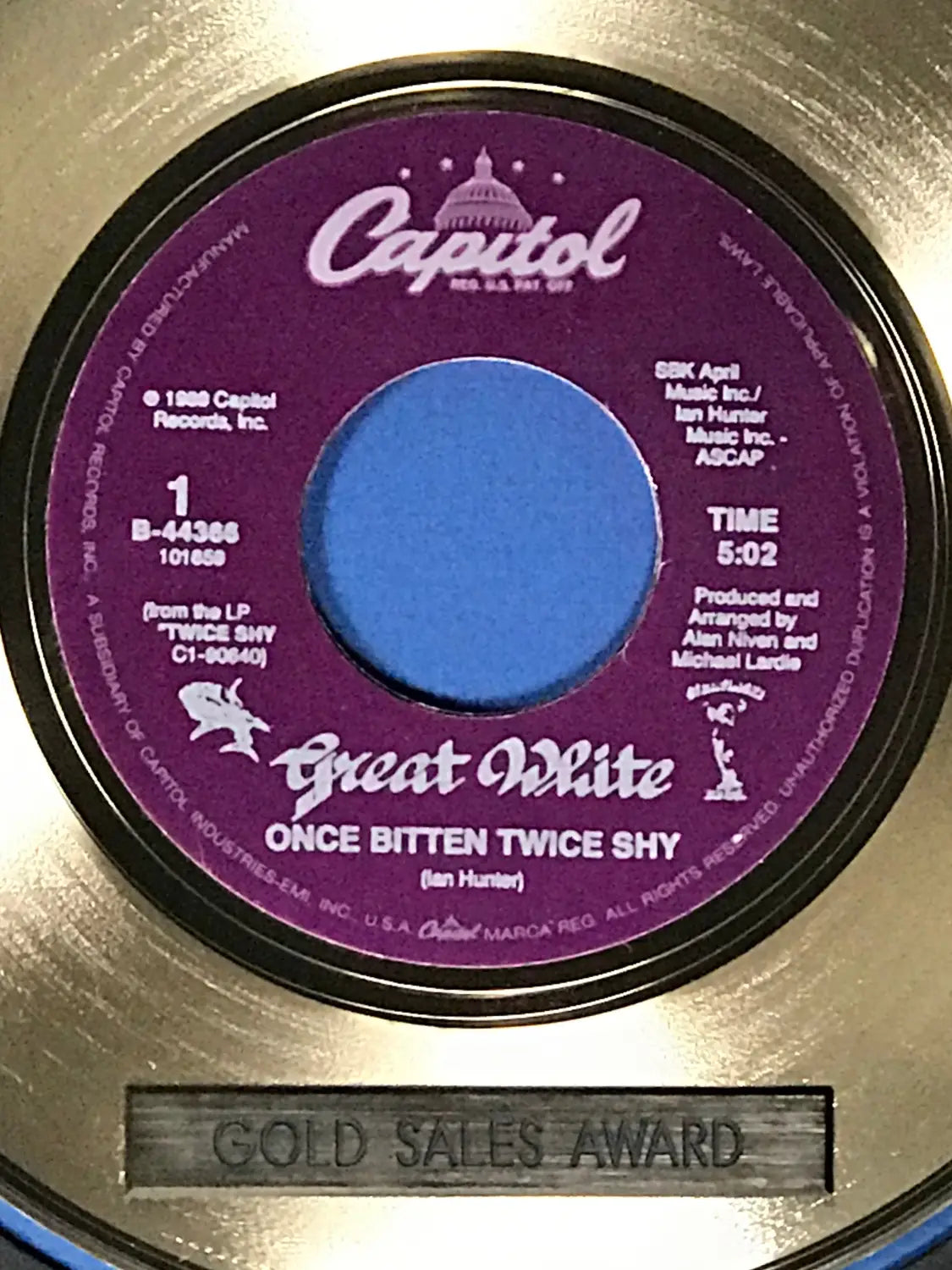
In contrast, this "R hologram" award for Pearl Jam's album Ten utilizes album artwork in the design. It marks the album being certified 2x Multi-Platinum on Aug. 4, 1992. Note the 1 and 2 Million sales plaques on the bottom left and right:
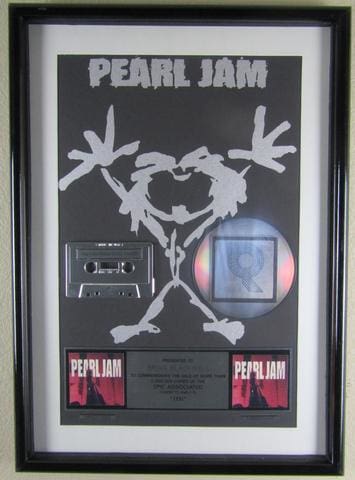
Introduced around 1989, a new award for Maxi-Singles was introduced. The main difference in these awards was that the sales standard required for Gold certification -- 250,000 sold -- was less than it was for albums or singles. Here's an example for one of Jay-Z's early successes, which was certified as a Gold Maxi-Single (or as the plate on this one states: "Maxi 12", Cassette and C.D.") by the RIAA on June 14, 1996 for 250,000 copies sold:
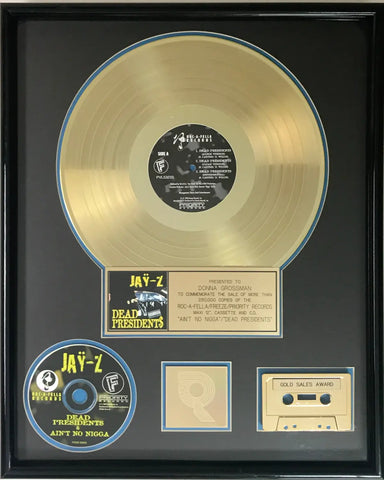
Multi-Platinum awards in the R hologram era could feature an array including multiple album miniatures, like this example for Nirvana's MTV Unplugged In New York as certified 3x Multi-Platinum by the RIAA on Jan. 13, 1995:
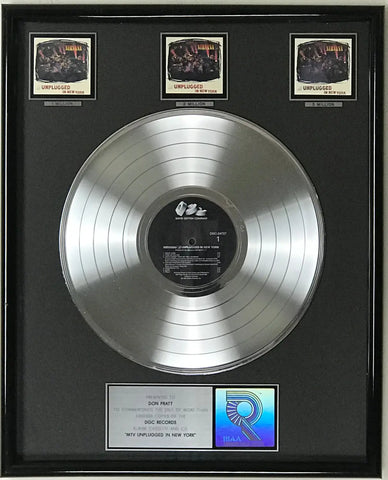
R hologram awards have been made to accommodate larger numbers of sales as well, such as this example for Pink Floyd's The Wall which also was designed with cassette and CD, showing its 8x Multi-Platinum status as certified by the RIAA on May 28, 1991:
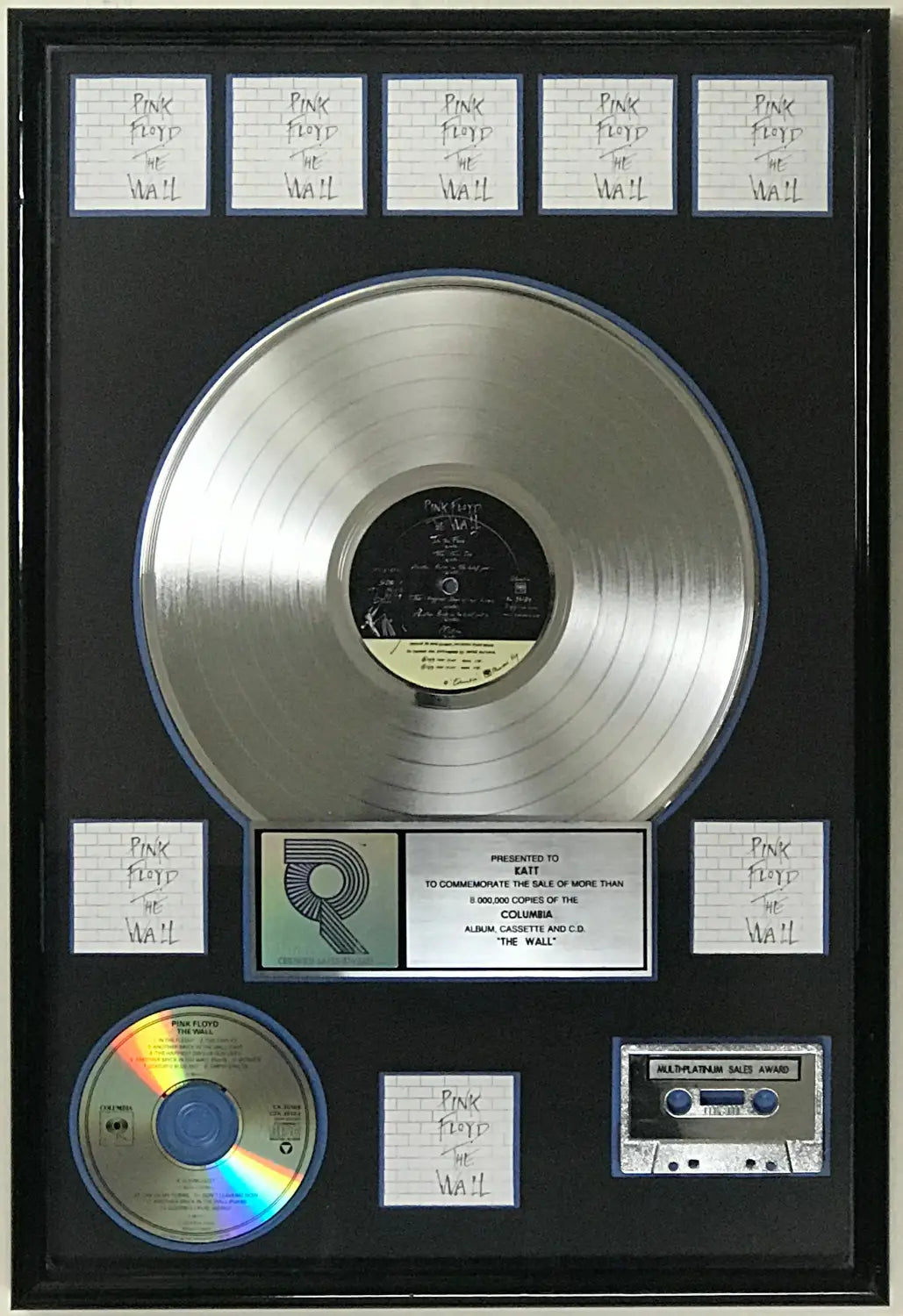
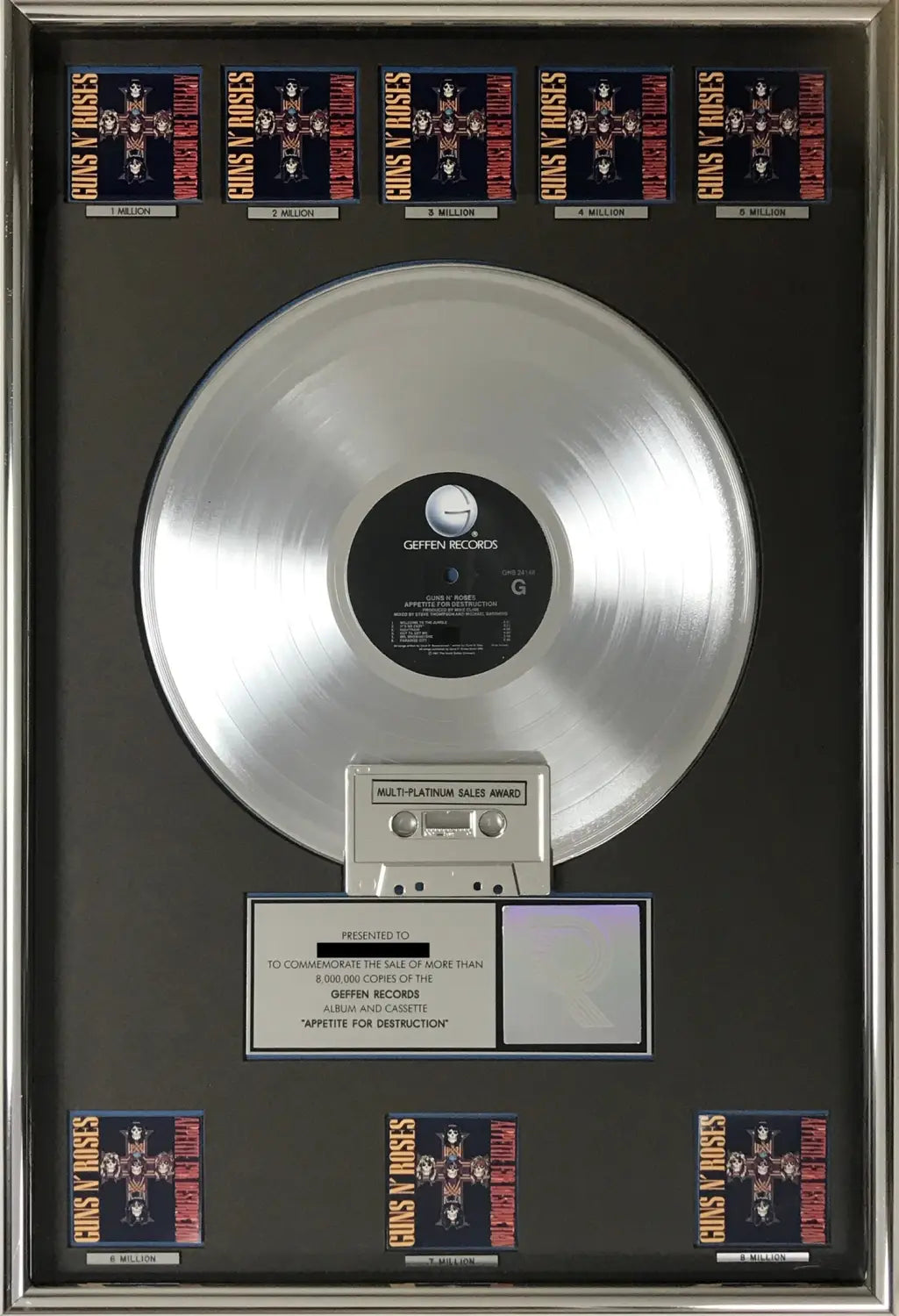
As seen previously, manufacturer stickers were continually evolving on the later awards. Here's the more modern Creative Glassics sticker typically found on RIAA R hologram era awards:
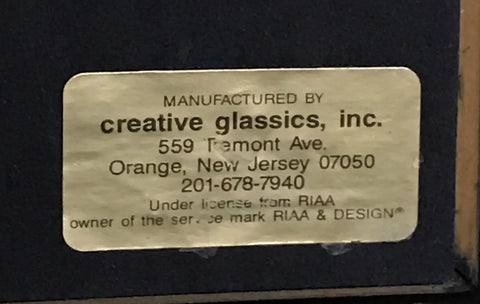
Here are Gold and Platinum Single awards made in 1990 from the "R hologram" period:
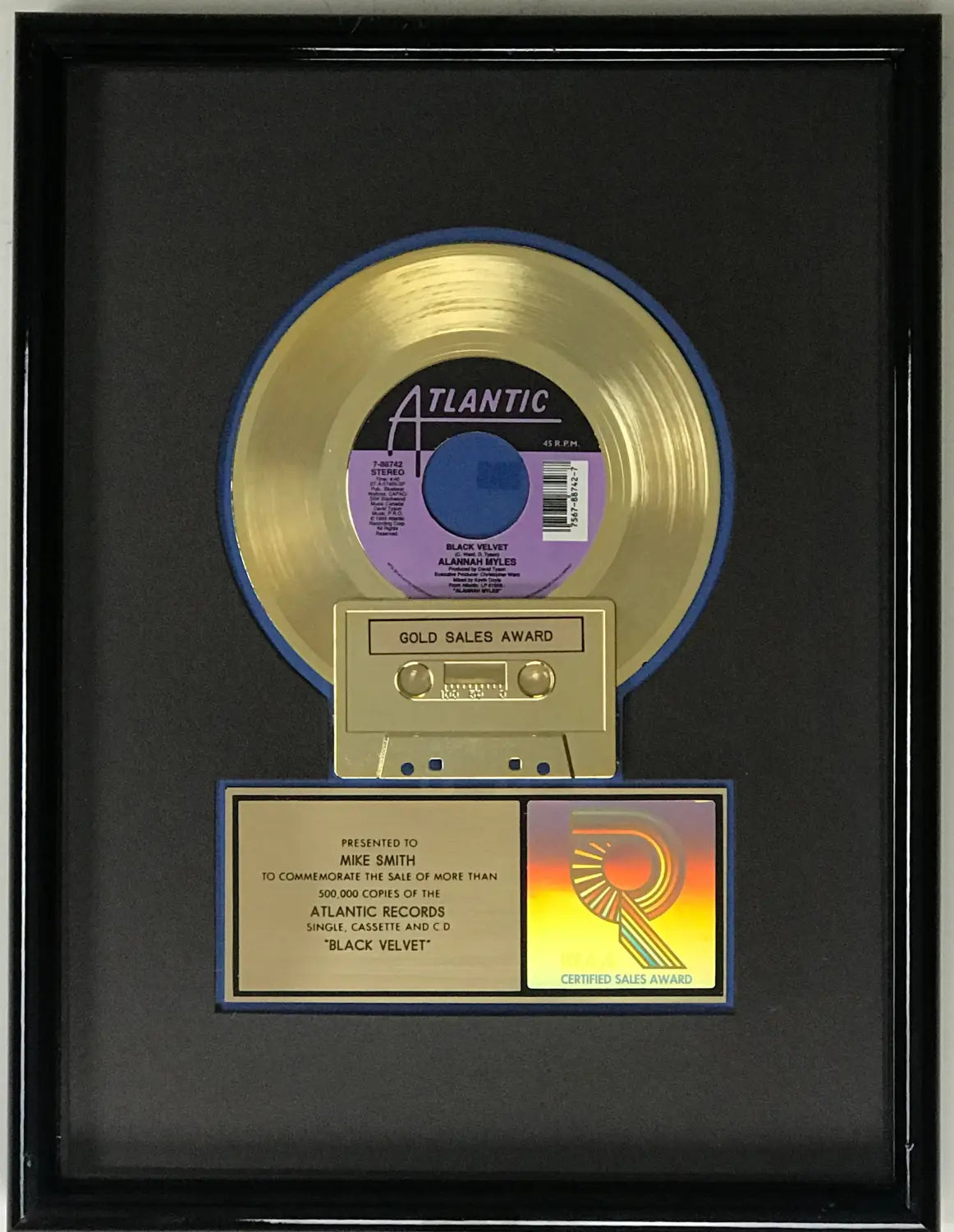
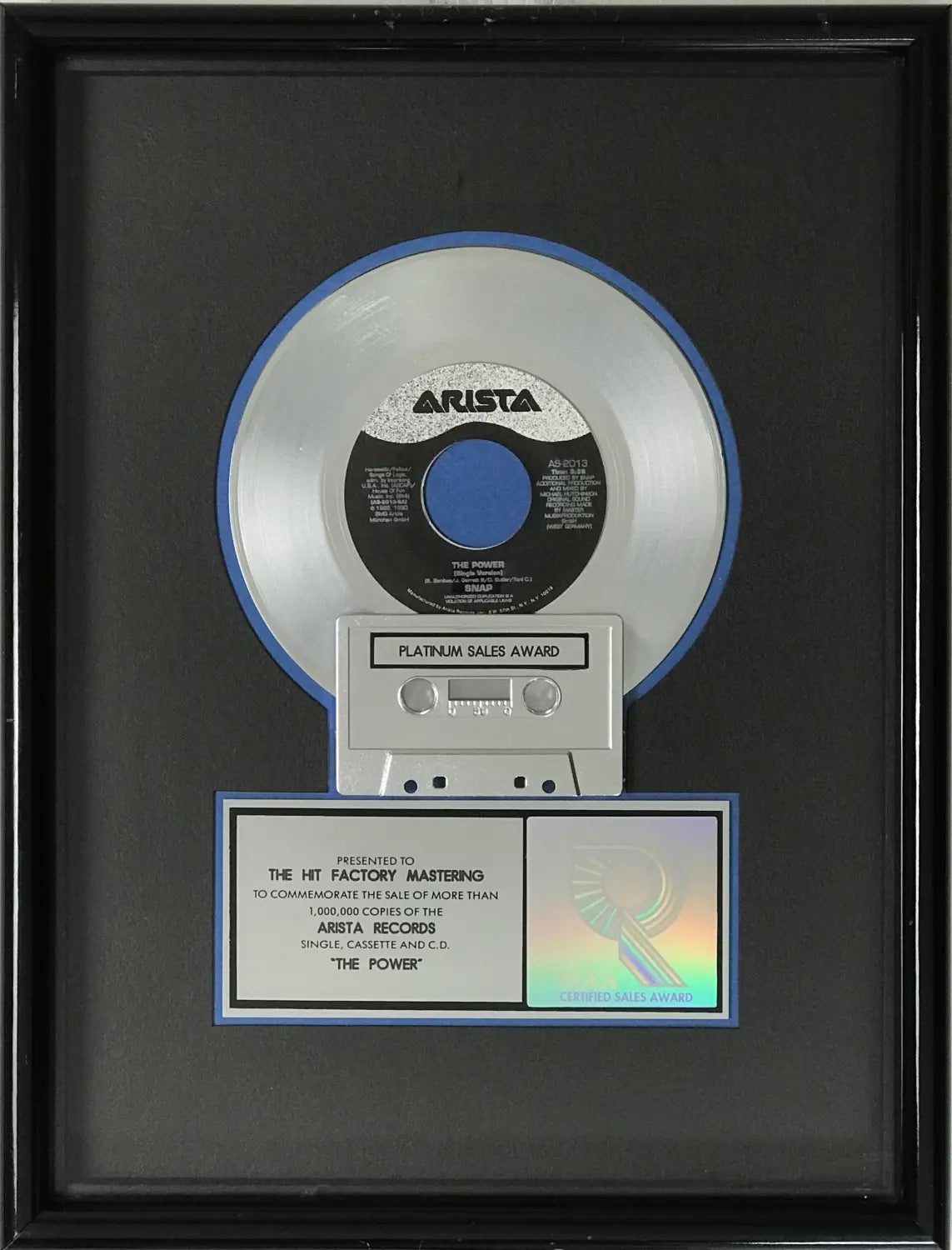
Here's a cassette-only "R hologram" era single award from 1991, which were fairly rare:
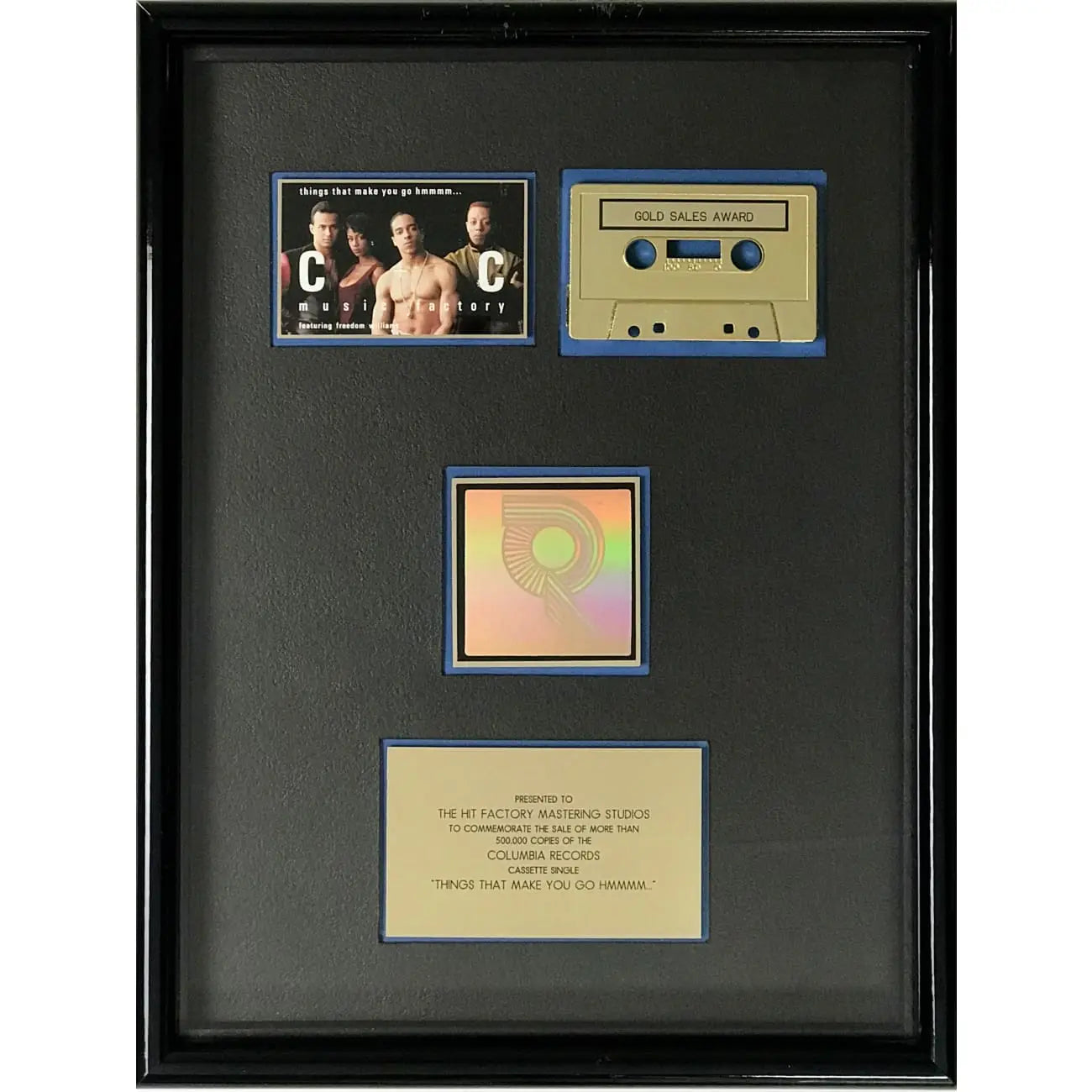
And here's a CD and cassette-only "R hologram" era single award from 1991, which were also fairly rare:
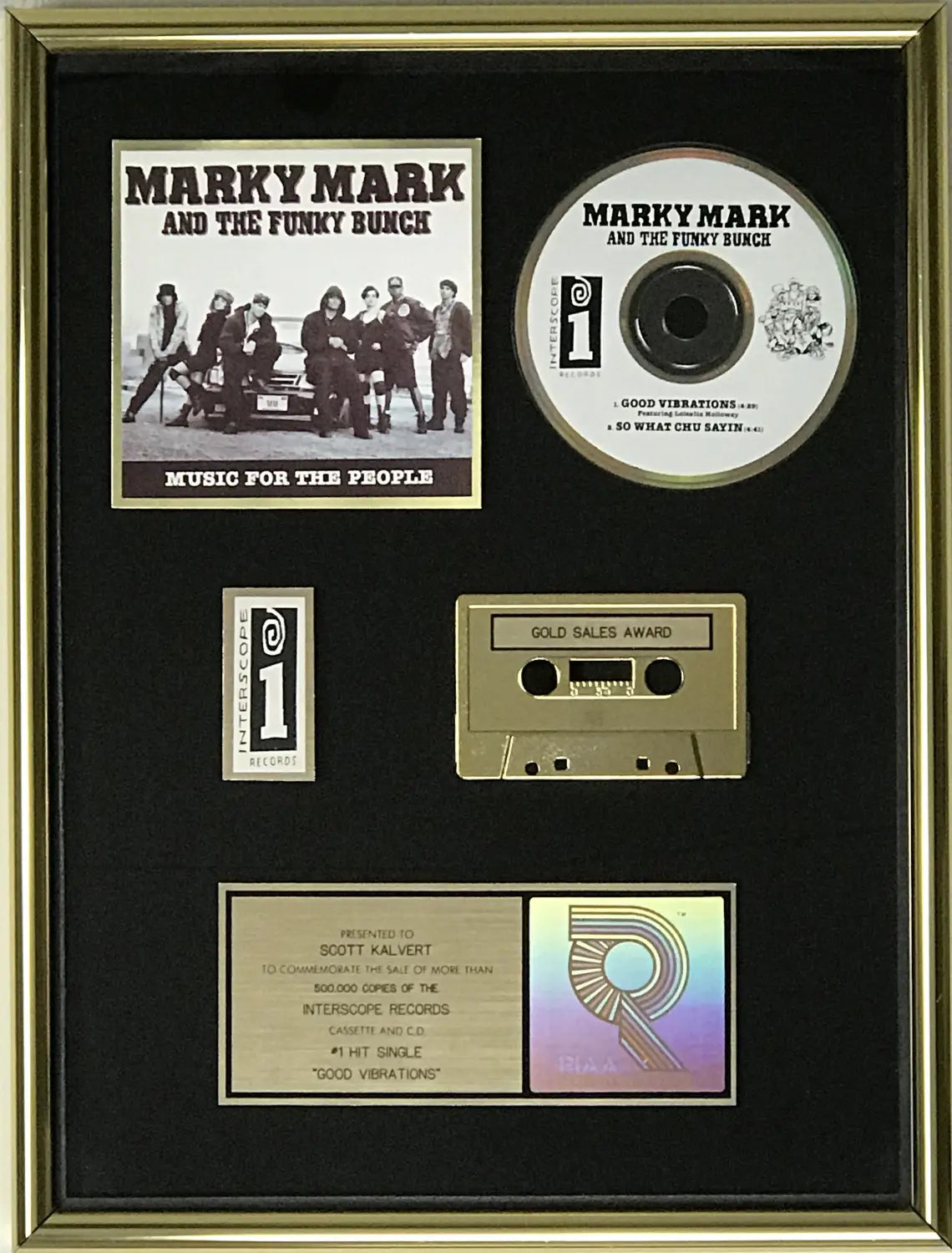
1998-present serial number "bar hologram" period: While the recipients and most other factors stayed the same, rigid standards of design have pretty much gone by the wayside by this time. Award designers have pretty much free reign to create awards in whatever manner they like.
The one constant element for 1997 and later awards is the redesigned RIAA hologram logo with a "bar" and individual serial number for each award, which helps the RIAA eliminate replica awards being made (or at least creates a mechanism to take them out of circulation if they are discovered).
Here's an example of a "bar hologram" for the Mer De Noms album from A Perfect Circle, which was certified Platinum on October 31, 2000. It features song lyrics printed around the disc:
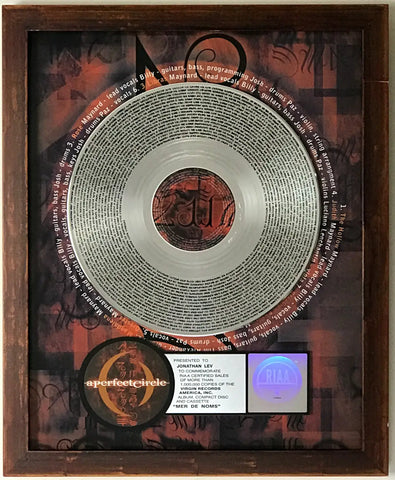
Here's a RIAA bar hologram example of an award for Fat Boy Slim from 1998 showing how unique the designs of some of the newest awards can be:
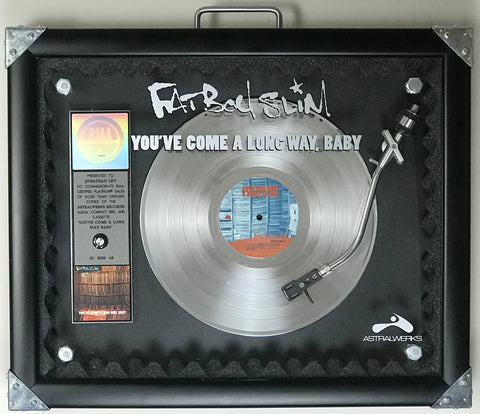
Here’s another. This all metal and plexiglass award is for Linkin Park's Hybrid Theory, which was certified Platinum on Jan. 10, 2001:
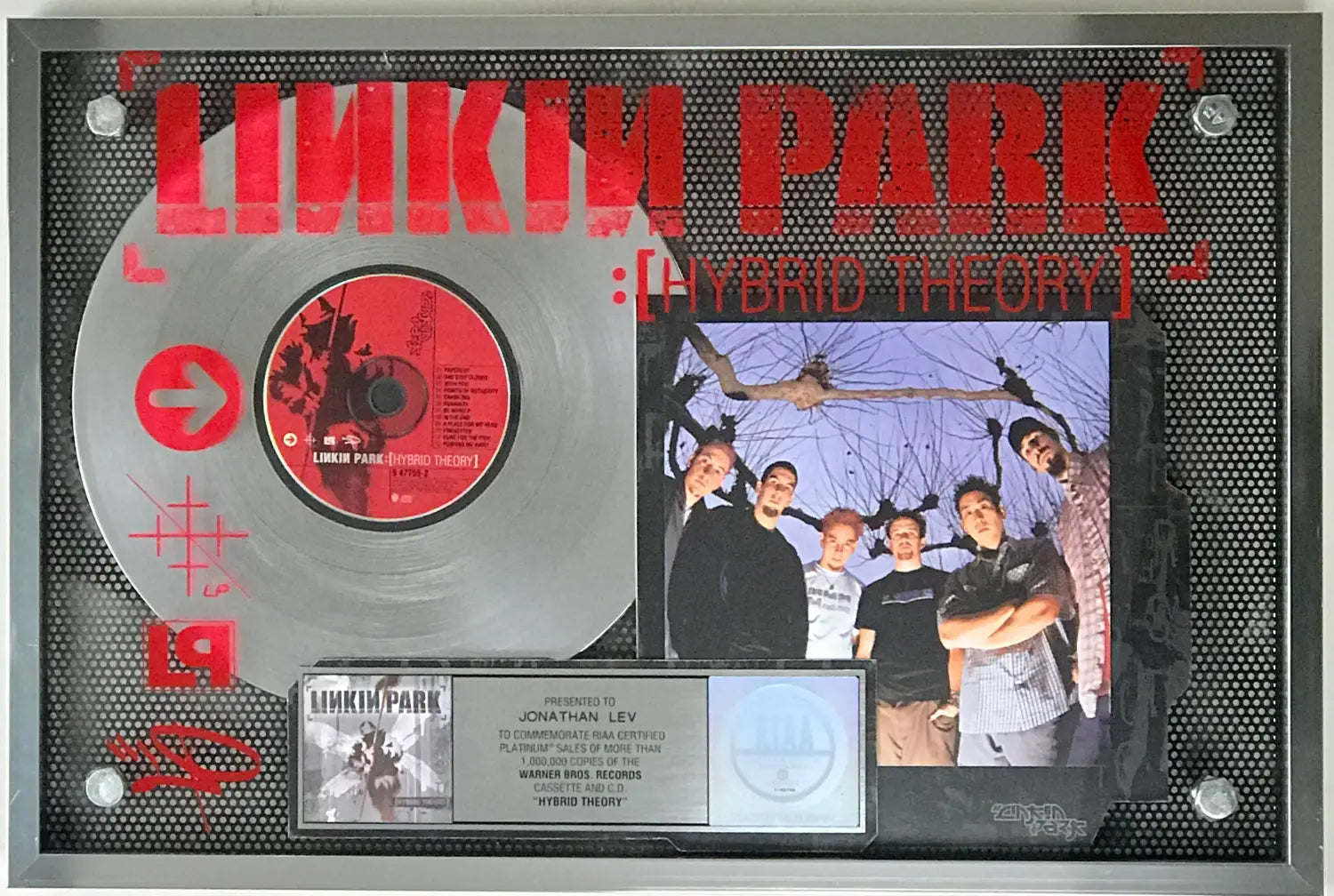
Here's an example of a modern era Multi-Platinum award, this one for 2Pac's "California Love" single, which was certified 2x Multi-Platinum on August 6, 1996. Note that, while it can be hard to distinguish from a regular paper label on the record in a photo, on many of the awards made in the 90s the center of the record actually also has a CD placed over it (shown in detail photo below full image):
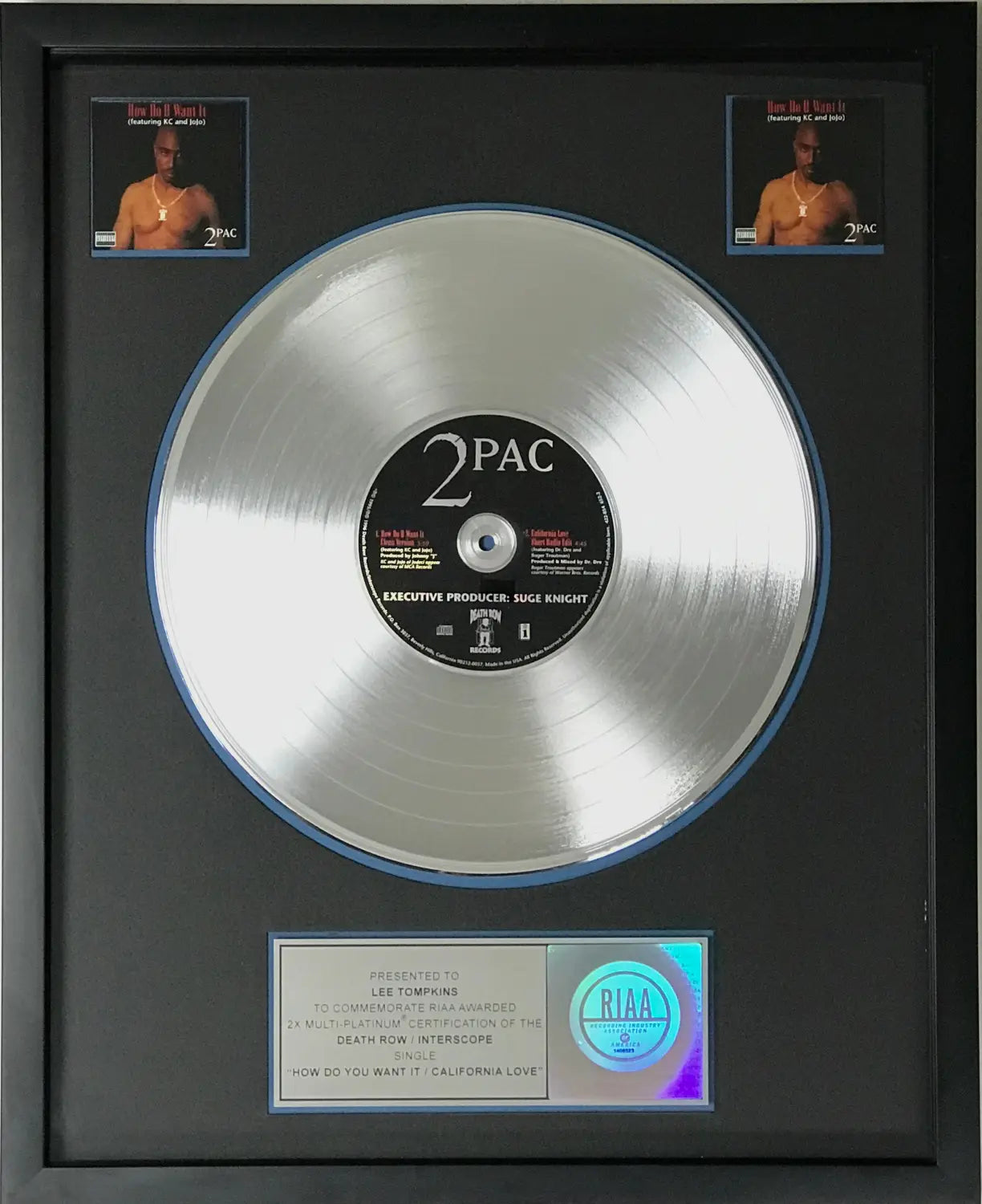
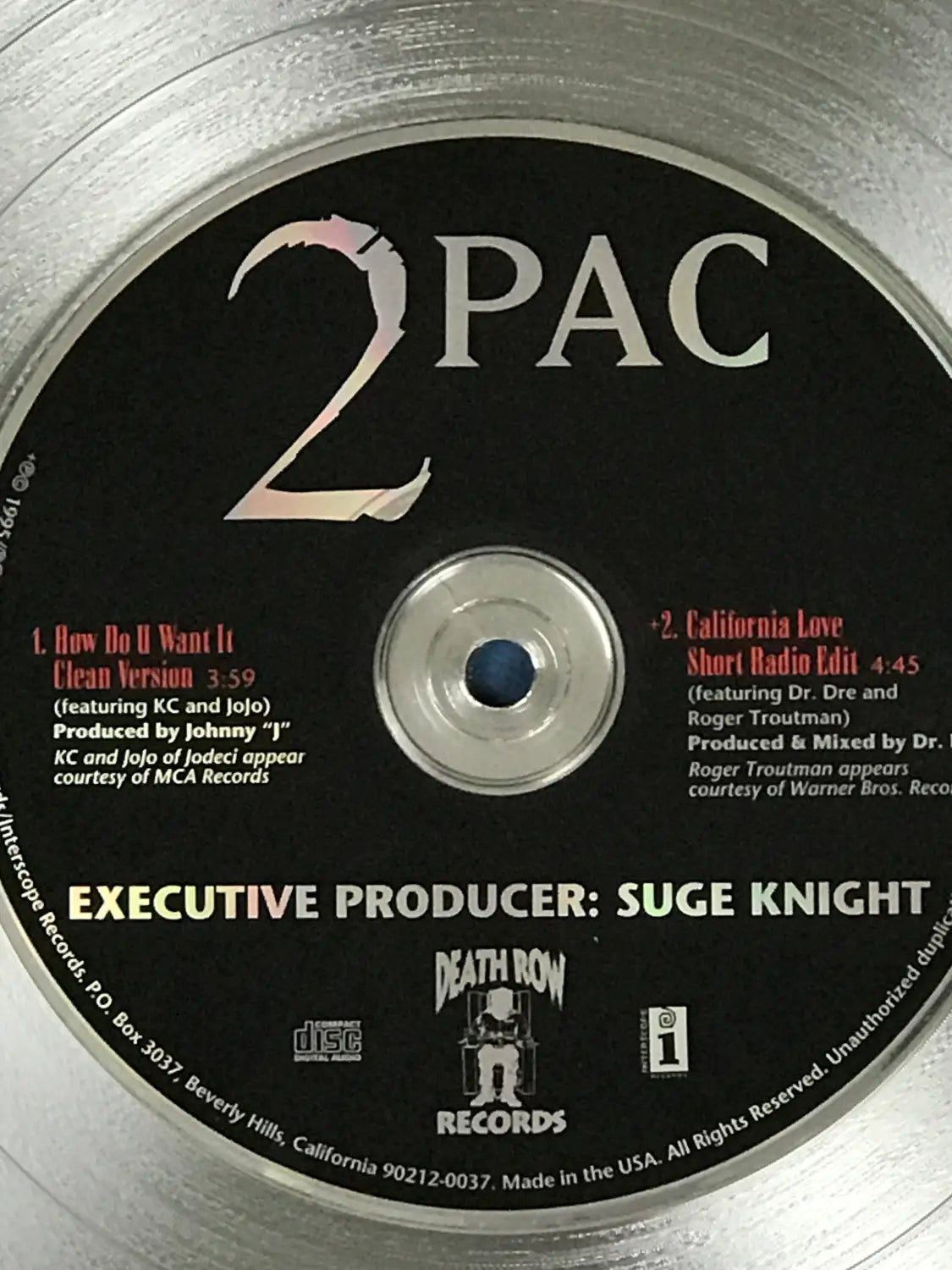
As digital sales and streams became a more prevalent in the marketplace, the RIAA included those sales in the certifications. Some plaques were designed with a special additional "Digital Sales & Streams" emblem included in the award, like this example for Beyonce (ft. Jay-Z) single "Drunk In Love":
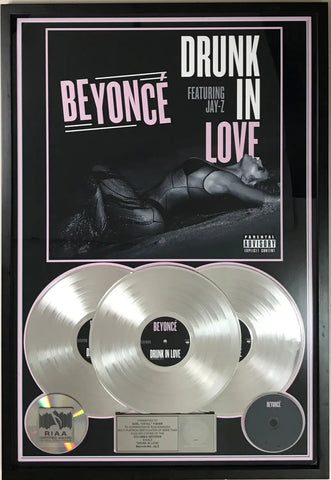
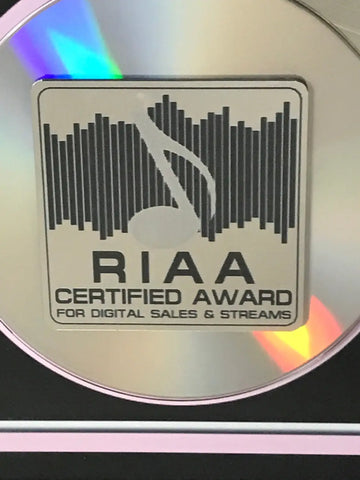
Here's another example, this one a RIAA Digital Single for Lady Gaga's "Born This Way", which was certified 3x Multi-Platinum on Feb. 29, 2016:
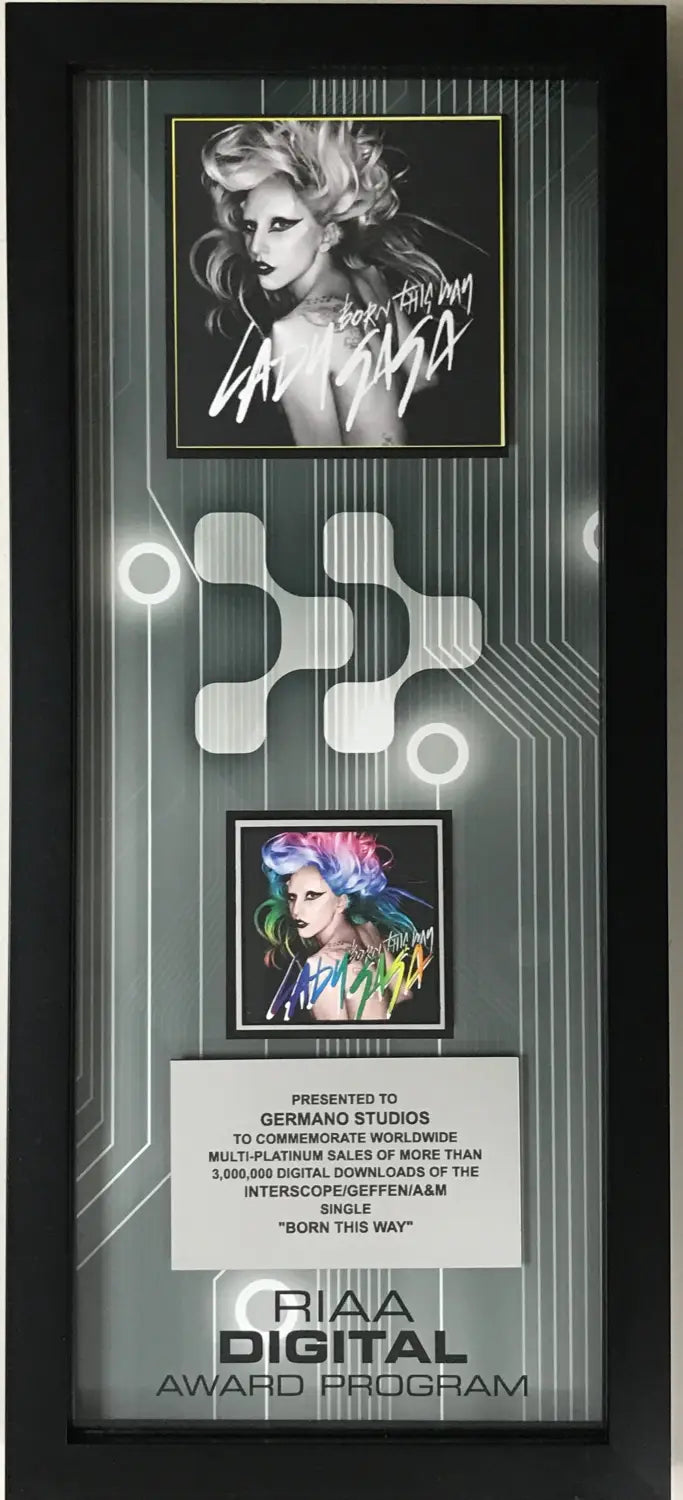
Finally, in one of the most unique designs the RIAA and an award maker ever came up with, here is a special 20x Multi-Platinum award made for Creed to recognize the combined sales of three of their albums and given to the group in the early 2000s. Amazingly, this one was designed to light up, with LEDs on the top and side:
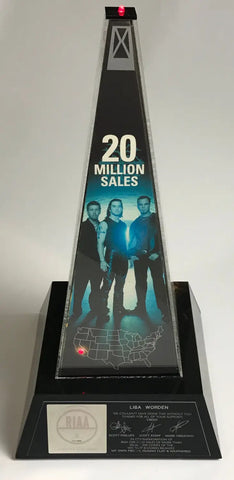
1999-present RIAA Diamond Awards: For sales of 10 million units or more
By virtue of the minimum 10 million in U.S. sales level, these are the rarest type of RIAA awards. Diamond awards have a unique and quite attractive construction. Produced only since 1999, the design is a creation of renowned crystal designer Peter Wayne Yenawine, who was a master designer at Steuben Glass and who has been commissioned by five U.S. Presidents to create gifts. The award is topped with a diamond-shaped 728 ct. crystal placed in a faceted sterling silver setting. This two-piece award is 12" high and the crystal spire and diamond-shaped crystal top sit on top of a black tapered 3-1/2" high base with is engraved with the recipient's name, the name of the album and the date. Here are photos of an example, presented to Bill Wyman of the Rolling Stones to recognize 12 million in sales of the Stones' 1971 release Hot Rocks, which was certified Diamond in 2002:
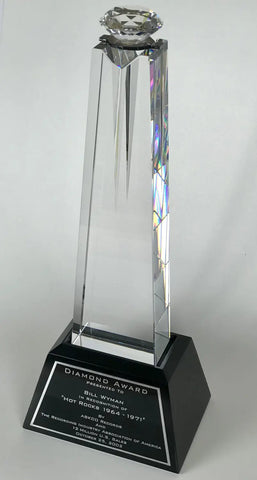
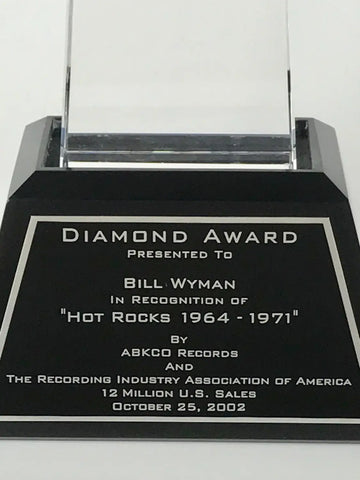
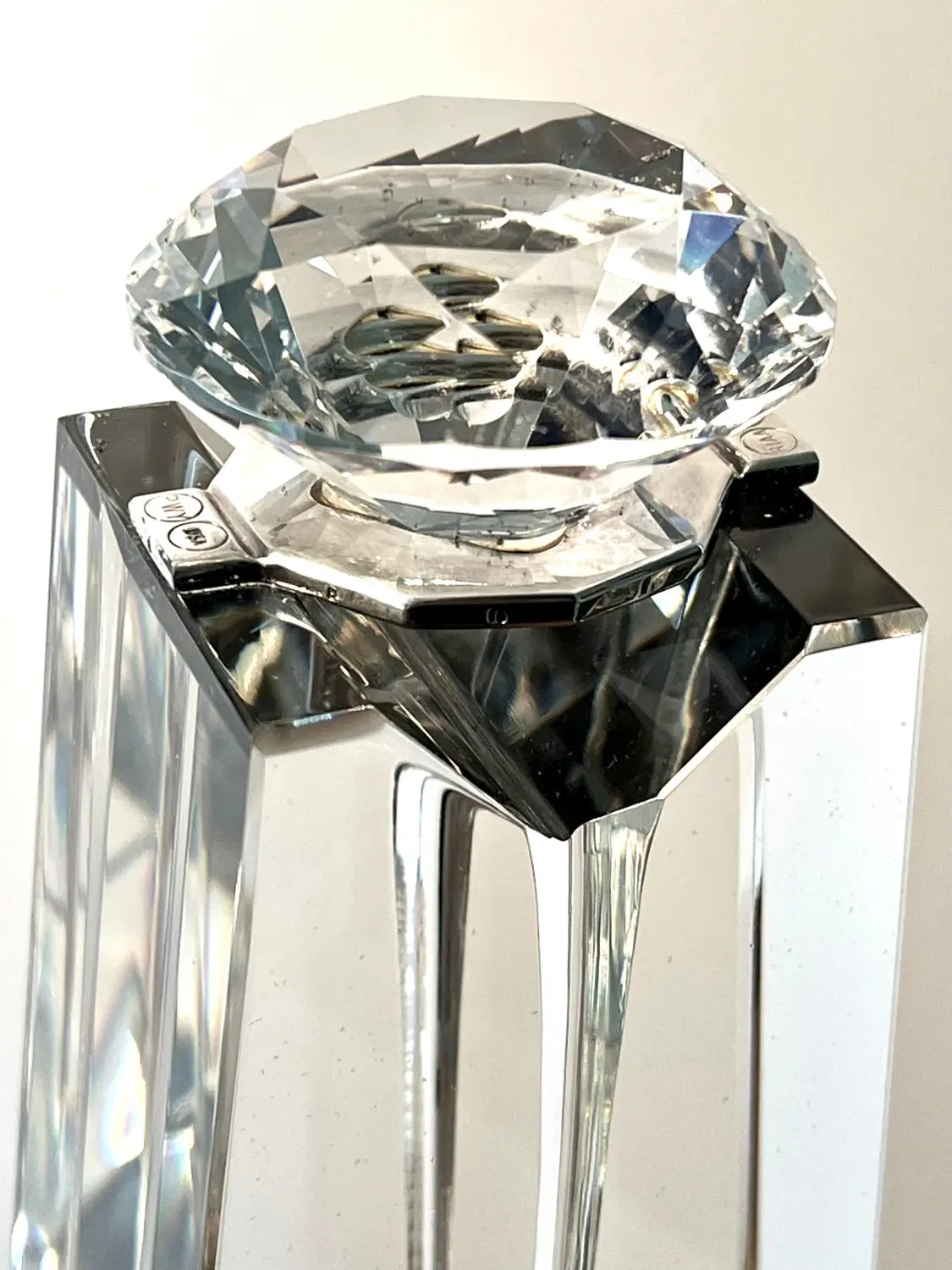
RIAA Video Awards
As MTV, VH-1 and other music video television channels exploded onto the music scene in the 80s, this gave birth to RIAA video awards as detailed above for VHS and DVD releases for music video singles (one or two music videos or tracks), longform video releases (concerts, music video compilations not previously theatrically released), and video box sets.
Very similar in appearance to RIAA awards for audio-only releases, they have changed a bit over the years while utilizing same RIAA logo seals and holograms based on year the awards was issued. Here are a few examples, starting with a RIAA Gold Video Award for the 1988 Judas Priest (Long Form VHS) Priest... Live!
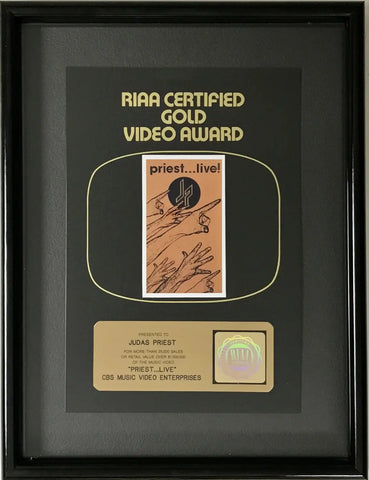
Here is a 1991 RIAA Gold (Longform VHS) Video award for The Doors Live In Europe 1968:
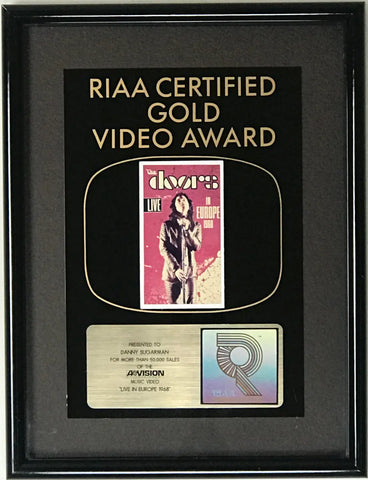
Here is a RIAA Platinum (Longform VHS) Video award from 1997 for The Rolling Stones Rock 'N Roll Circus:
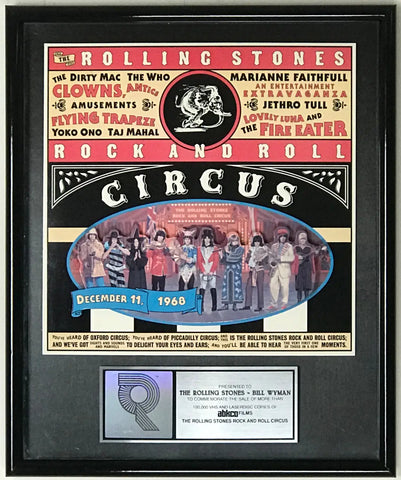
Here is a RIAA Platinum (Longform DVD) Video award from 2004 for Duran Duran's Greatest:
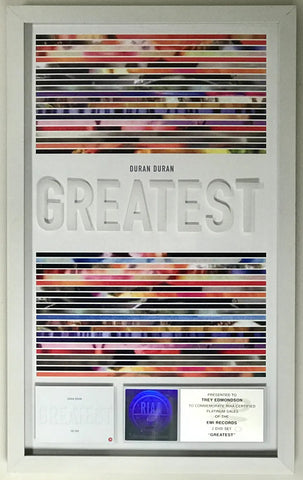
More Detail On RIAA Presentation Plates Through The Years
In addition to the correct RIAA logo for the era of award (see a pictorial guide below) the notation on the presentation plate has changed over the years as referenced earlier. Here are two examples that illustrate this changing language.
From 1958-1974 the RIAA counted records sold for singles, but instead counted dollar amounts generated for albums. This was because very few LPs sold in large quantities in those earliest decades when the business was singles driven.
This would change dramatically with arrival of the 70's and advent of concept albums and Album Oriented Rock (AOR) radio stations which played more and deeper cuts off of albums, thus piquing consumer interest in buying albums.
So, while an album/LP presentation plate from a white matte (1964-74) Gold award read like this:
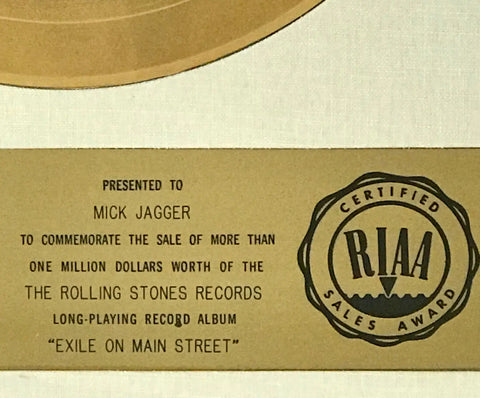
A floater (1975-81) Gold award album/LP presentation plate read like this:
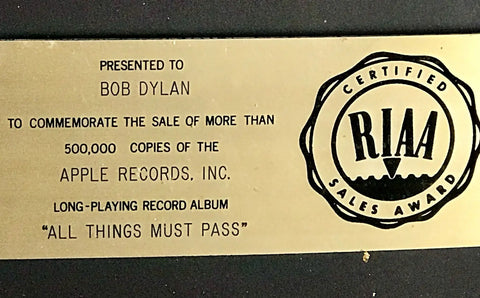
And a floater Platinum award album/LP presentation plate (made 1976-81 since the Platinum program only started in 1976) read like this:
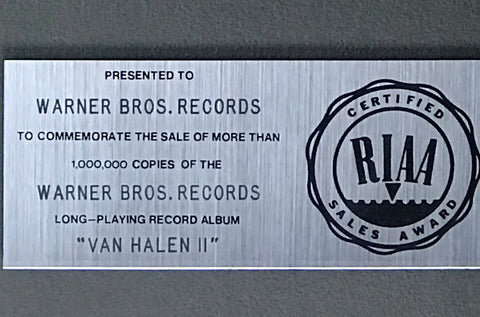
It's worth noting that fonts vary somewhat across RIAA info plates from white matte and floater awards from 1964-1981, and also afterwards. While there is general uniformity, you will see some variation.
Later awards, like The Fray "bar hologram" award example above, could even include a logo of the recipient's company. In that example, the plate features a VH-1 logo since the music executive worked for the music video channel. Of course the main distinguishing feature of bar hologram awards is that each also bears a unique serial number for each award made inside the hologram logo.
RIAA Logos Through The Years
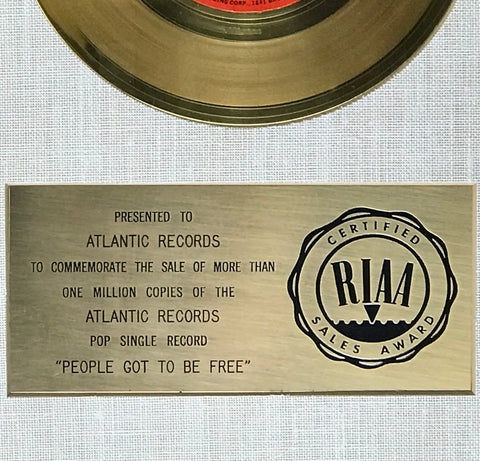
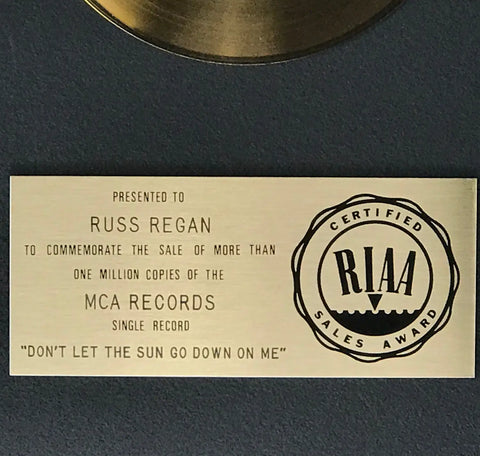
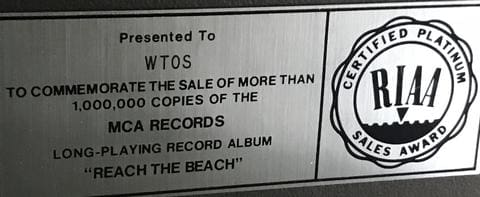
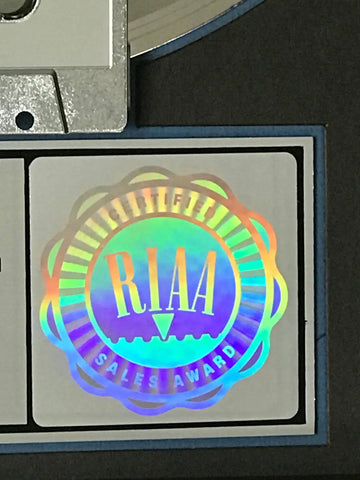
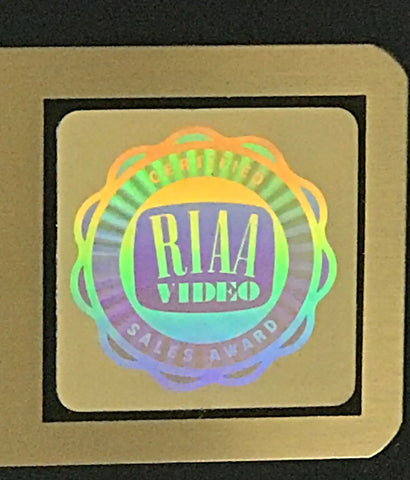
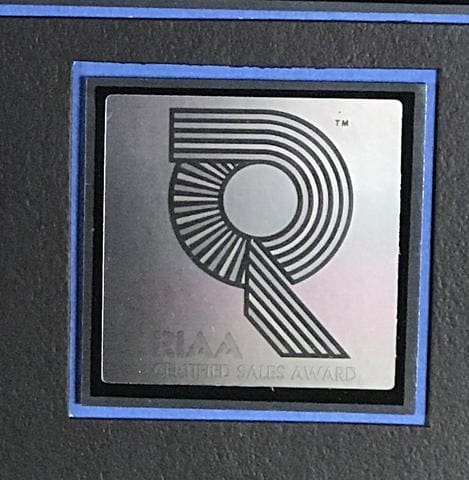
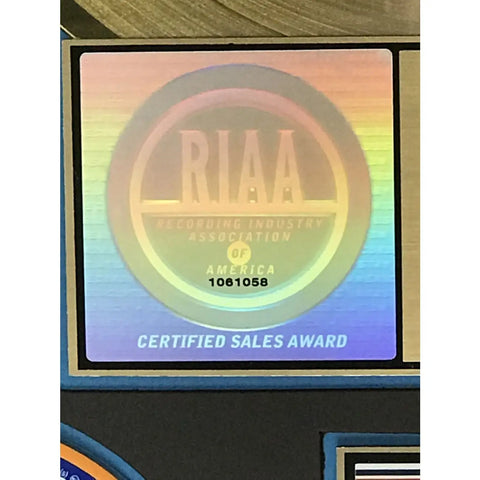
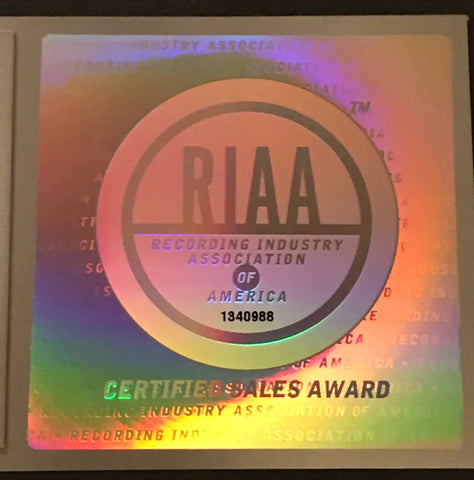
Initial Presentation Vs. Later Presentation
The RIAA will issue a new award for any certified recording any time the label who released the recording requests it. However, the award will be created in the design style that is current at the time of the request. That said, for orders made in very recent years, there are a range of styles available from the RIAA-authorized manufacturers. Some of the designs are throwbacks to earlier year styles, but none match them perfectly.
In terms of what era of award you will see in existence for a given recording, most typically the first time a project reaches a sales mark and the label has provided the appropriate documentation to prove the level of sales, the RIAA will authorize the creation of an award. This will normally be to create a Gold award and that will be referred to by some collectors as a "First Presentation." A subsequent request for an award at a later date after the award format has changed is known as a "Second Presentation," the third time a "Third Presentation" and so on.
For example, Led Zeppelin's first album was certified Gold on July 2, 1969, so the First Presentation award (if the label requested it at that time) would be in a white matte format. If the label requested another award for the Gold presentation in, say, 1977, it would be produced as a floater award. Then, if an award was requested in 1983 it would be a strip plate award, and so on.
Some interesting situations result when a label does not submit documentation at the time that a project initially sells to a certain level. This can result in a record being recognized the first time with a later format award. Here's an example:
The Beatles Abbey Road album was released on Oct. 1, 1969 and went Gold quickly, certified on Oct. 27, 1969. It also certainly had sold well over a million copies by 1976 when Platinum awards were first launched. However, the first Platinum certification for the record didn't come until Dec. 26, 1991. This is likely because the label had not filed the paperwork to document the sales until that date. In fact, it was certified Platinum and 9x Multi-Platinum that same day. Thus, the First Presentation RIAA Platinum award ever issued for the Beatles Abbey Road would have been a fairly modern "R hologram" 1990-97 style award.
How To Avoid Buying Fake or Replica Awards
First you should assess whether an award you find has all the right components for its era as per the above examples.
One way to determine right away if the components are likely to be correct is to inspect the backing paper. Original backing papers will be brittle, show some aging appropriate to the age of the award, and ideally include the original manufacturer's sticker. Some minor tearing is fine and in fact is very common but unless the entire original backing paper is torn, this most likely indicates that the internal components of the award have not been tampered with.
If an award has been re-backed, in some people's eyes it may lose value (at least for a hardcore collector) but it may not indicate a problem. However, it should cause you to inspect the award's internal components more carefully.
Here's what to look for when inspecting the components, and use the award descriptions, years and details above to check against the award you are assessing:
Check the certification date on the RIAA website (https://riaa.com/gold-platinum) for the award. The site features an easy to search database of all RIAA sales certifications. The date will tell you what style the award should be and also can provide clues as to what the other components, such as the record label and album miniature, should look like.
The style of award should be correct for the era of the award. For example, it would be impossible for Queen single "Bohemian Rhapsody," which was released on Oct. 31, 1975 and certified Gold on June 3, 1976 to be a white matte award since no white matte awards were made after 1974. Instead, it should be a floater style award with its typical charcoal-colored matte.
The record label should be correct for the era of the award. For example, it would be impossible for the Beatles earliest releases to have an Apple Records Ltd. record label on an pre-1968 white matte RIAA award since Apple Records was not formed until 1968. An early Beatles single like "Hard Day's Night" would have the label like the one on top below on its white matte award if it was produced pre-1968, whereas a 1975-81 floater award would have the label like the one on the bottom:
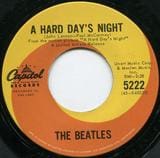
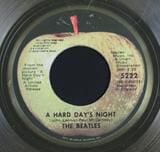
The album miniature (on LP awards) has the correct album cover for the date the award was produced since many later reissues of albums feature alternate covers.
The RIAA presentation plate should have the correct language on it for the era of the award. Refer to our section above on this for info. There should also be no spelling mistakes on the plate, especially in the standard language referenced above. The RIAA would typically ensure that awards with spelling mistakes were recalled and remade. That doesn't mean there aren't mistakes out there. Check out this award we spotted in an unnamed Hard Rock Cafe location (Pete Tonshend of The Who, anyone?):
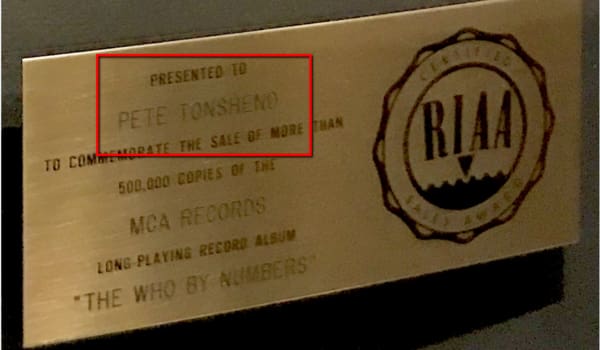
The RIAA logo is correct for the era of the award. Refer to our images above for info. Also, let's go back to the replica awards you see on the market like our ELO example. While most aware buyers would not mistake them for real awards, it does happen. Note on this piece that the graphic on the metal info plate is designed to look suspiciously like an actual 1970's era RIAA certified sales award logo:
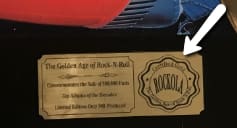
Compared to a real 70's era RIAA logo:
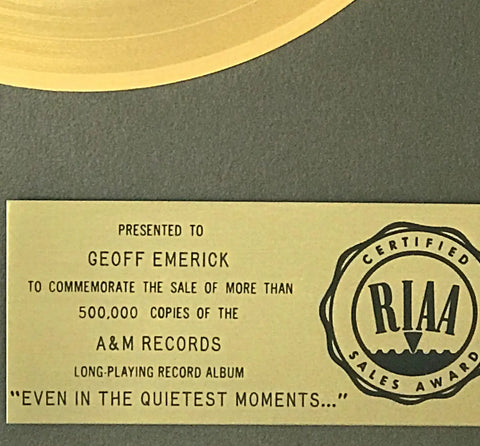
This is just one of many replica/artwork awards on the market. Nothing wrong with them, but just don't mistake them for real RIAA awards.
Final note on finding authentic awards: Due to manufacturing methods and inconsistencies in materials available in the 60's and 70's, there were certainly some minor variations in the awards produced over time. We learned this clearly when talking to employees of the only two companies that made the awards across those two decades.
Further, since the RIAA will not authenticate awards in the marketplace, it is up to collectors to sort things out and no one collector has seen every award out there. These factors combine to make essentially no one an expert in determining the authenticity of some of the awards in the marketplace.
Most moderately aware buyers can avoid the most obviously fake awards but if you want the most assurance that an award is real, use the info in this article and elsewhere to become an informed buyer.
What Awards Are Most Valuable For Collectors?
This is, of course, a subjective area with some of the advice being what you'd expect and exceptions will always apply. Here are a few of the highest prices fetched by RIAA awards in auction house sales over the last decade or so:
- The Beatles, Hey Jude, Gold LP 1964-74 white matte presented to the Beatles, $91,000, Julien’s Auctions 5/20/23
- The Beatles, Abbey Road, Gold LP 1964-74 white matte presented to the Beatles, $78,000, Julien's Auctions, 5/20/23
- The Beatles, Sgt. Pepper's Lonely Hearts Club Band, Gold LP 1964-74 white matte presented to the Beatles, $73,214 (£43,750) Christie's, 6/20/14
- The Doors, Morrison Hotel, Gold LP 1964-74 white matte presented to The Doors, $32,000, Julien's Auctions, 5/19/18
- The Beatles, Magical Mystery Tour, Gold LP 1964-74 white matte presented to the Beatles, $30,880 (£20,000), Christie's, 6/12/12
- John Lennon and Yoko Ono, Plastic Ono Band, Gold LP 1964-74 white matte presented to John Ono Lennon, $30,880 (£20,000), Christie's, 6/12/12
- The Beatles, Abbey Road, Gold LP 1964-74 white matte presented to the Beatles, $30,400* (£20,000), Christie's, 6/26/13
- The Who, Live At Leeds, Gold LP 1964-74 white matte presented to Keith Moon, $25,133 (£13,200), Christie's, 11/21/06
*Amount in U.S. dollars was lower due to British pound exchange rate fluctuation.
For a look at the more top prices attained by awards in known auctions, check out our article which we update over time with latest top prices here.
Now let's look at the attributes commonly seen as the most desirable among "serious" collectors.
Most desired attributes?
Oldest awards: Walnut plaques of course, followed by white mattes, which continue to fetch impressive amounts in auctions worldwide, then floaters which are gaining in value the older they get, followed by more modern awards.
Well-known artists: Unsurprisingly, the current top group (in no particular order) probably includes the Beatles, Jimi Hendrix, The Doors, Bob Dylan, Led Zeppelin, Elvis Presley, Nirvana, Michael Jackson, The Rolling Stones, Queen, Prince, Elton John, Buddy Holly, The Who, and Van Halen, with many other well-known artists also making appearances at times in top sales.
Recently deceased artists: Morbid as it may be, death sells and RIAA awards of the recently departed Whitney Houston, Michael Jackson, Tom Petty, Kurt Cobain, Van Halen (given Eddie's passing), and Prince have all seen significant bumps in value.
Well-known, classic songs: Examples of top sales based primarily around the appeal of the song have certainly included "Candle In The Wind", "Hey Jude", "(I Can't Get No) Satisfaction", "Magic Carpet Ride", "Born To Be Wild", "Bohemian Rhapsody" among many others.
Presented to: The award presentations, ranked by most- to least-desirable seem to more or less be:
- Solo artist name (Elvis Presley, Prince, etc.) or individual member of a group (Mick Jagger, Freddie Mercury, etc.) with the highest profile member of group fetching the most, typically. As always, there are exceptions such as deceased group members.
- Special celebrity. Example: An RIAA Gold award for "Gonna Fly Now", the theme from the movie Rocky by essentially unknown artist Bill Conti sold in 2015 for $8,125, likely because its' presentation plate read "presented to Sylvester Stallone"
- Group (The Rolling Stones, the Beatles, Led Zeppelin, etc.)
- Producer, songwriter or engineer of note (Geoff Emerick, Quincy Jones, George Martin, Phil Ramone, Bernie Taupin, etc.)
- Record label (Elektra, RCA, Columbia etc.)
- Manager or industry executive of note (Peter Grant, Clive Davis, etc.)
- Industry executive, lesser known
- Record stores, radio stations, distributors
- Hard Rock Cafe (since most of these were made later especially for HRC in a display deal they made with the RIAA)
Get Out There and Find Your Gold... and Platinum, and Multi-Platinum...
So there you have it, a detailed rundown on RIAA awards. There are always more nuances, details and stories to discover around these awards the longer you collect them. We hope you enjoy discovering these interesting pieces of musical history as much as we have. Happy hunting for record award treasures!
Check out our current selection of RIAA Gold and Platinum and other record awards for sale here.
Photo credits (in order displayed):
Multi-RIAA award image: Ole Bendik Kvisberg [CC BY 2.0], via Wikimedia Commons
Aretha Franklin group: Public Domain
RIAA awards in wall display: Deidre Woollard [CC BY 2.0], via Wikimedia Commons
Cowsills with white matte RIAA award: MGM Records - eBay itemphoto frontphoto back, Public Domain, Link
All other photos: MusicGoldmine.com
Sources for this article and other info:
https://riaa.com - Official site of the Recording Industry Association of America, the organization that created RIAA awards.
http://honormusicawards.com - This is the website of a prolific collector of RIAA awards. He displays images of many of his personal collection of awards on his website.
https://www.billboard.com/articles/news/7550080/chasing-history-the-world-of-collecting-gold-platinum-and-diamond-records - An interesting article from Billboard magazine about collecting RIAA awards.
https://www.ratherrarerecords.com/riaa-gold/ - Music writer Neal Umphred explores in this article the changing sales measures used over time by the RIAA.
Feel free to share this article, but please only share in its entirety and leave all hyperlinks intact and active for copyright and credit reasons.
Want more content like this? Sign up for our free newsletter here.
Important Notice/Disclaimer: While many record awards and music memorabilia items appreciate in value, others fall in value and MusicGoldmine.com makes no claims, express or implied, that any item will appreciate in value at any time in the future. Further, MusicGoldmine.com is not providing investment advice in any of its' content.

